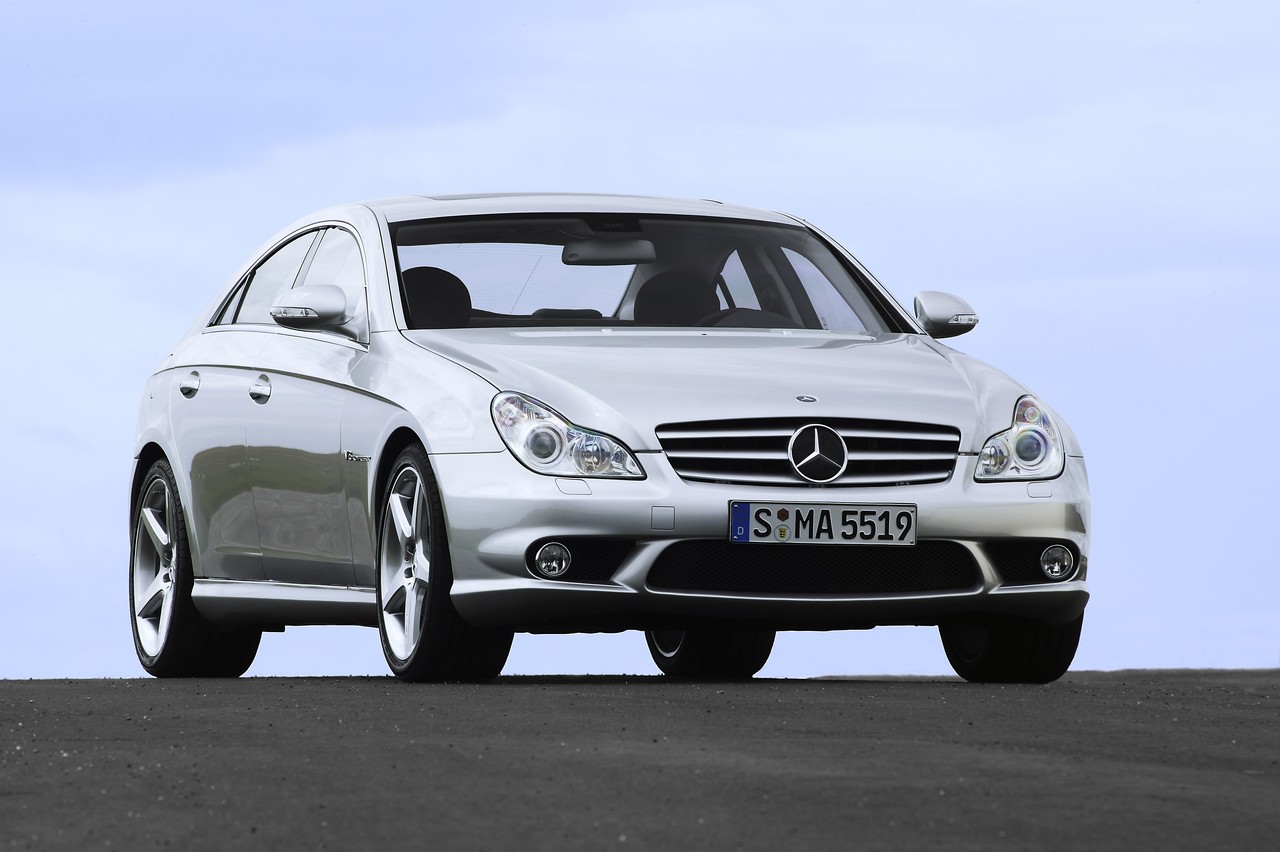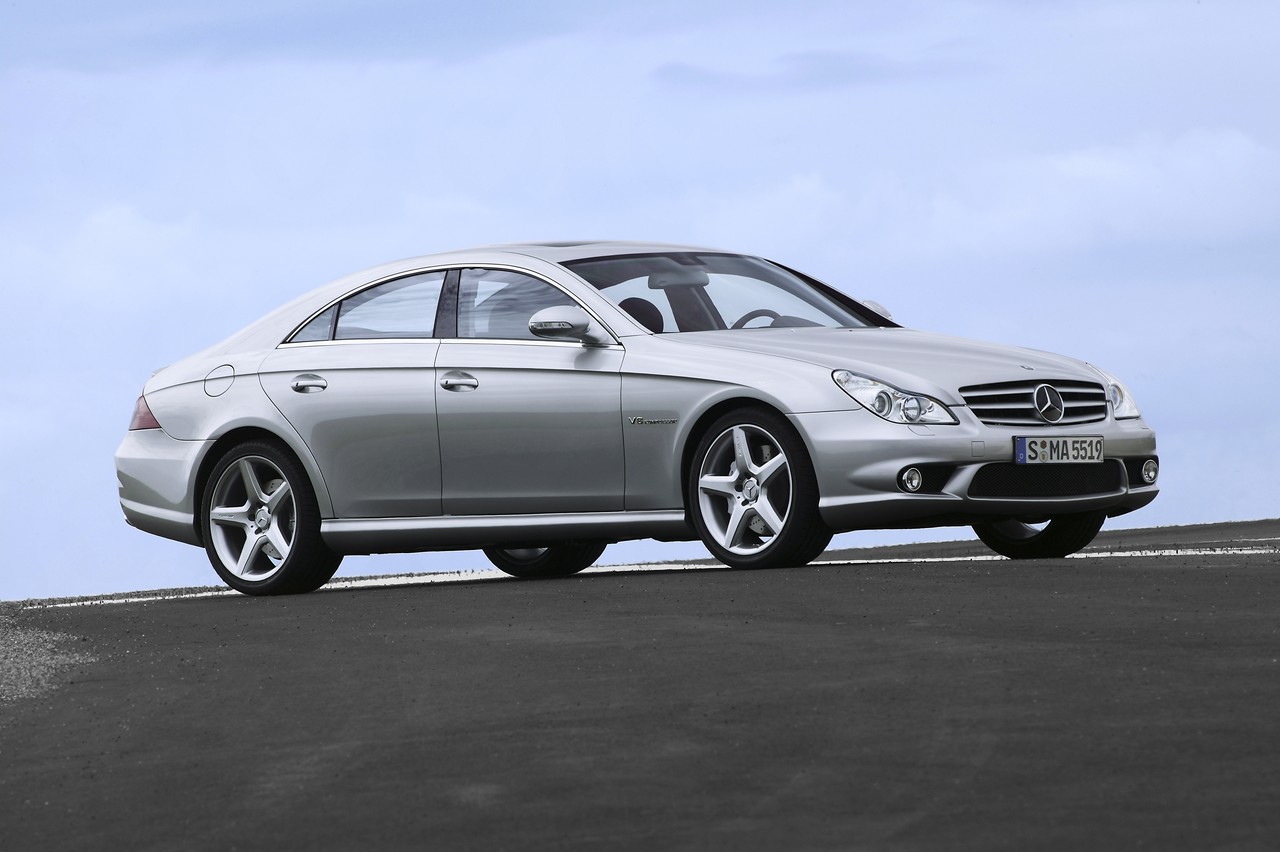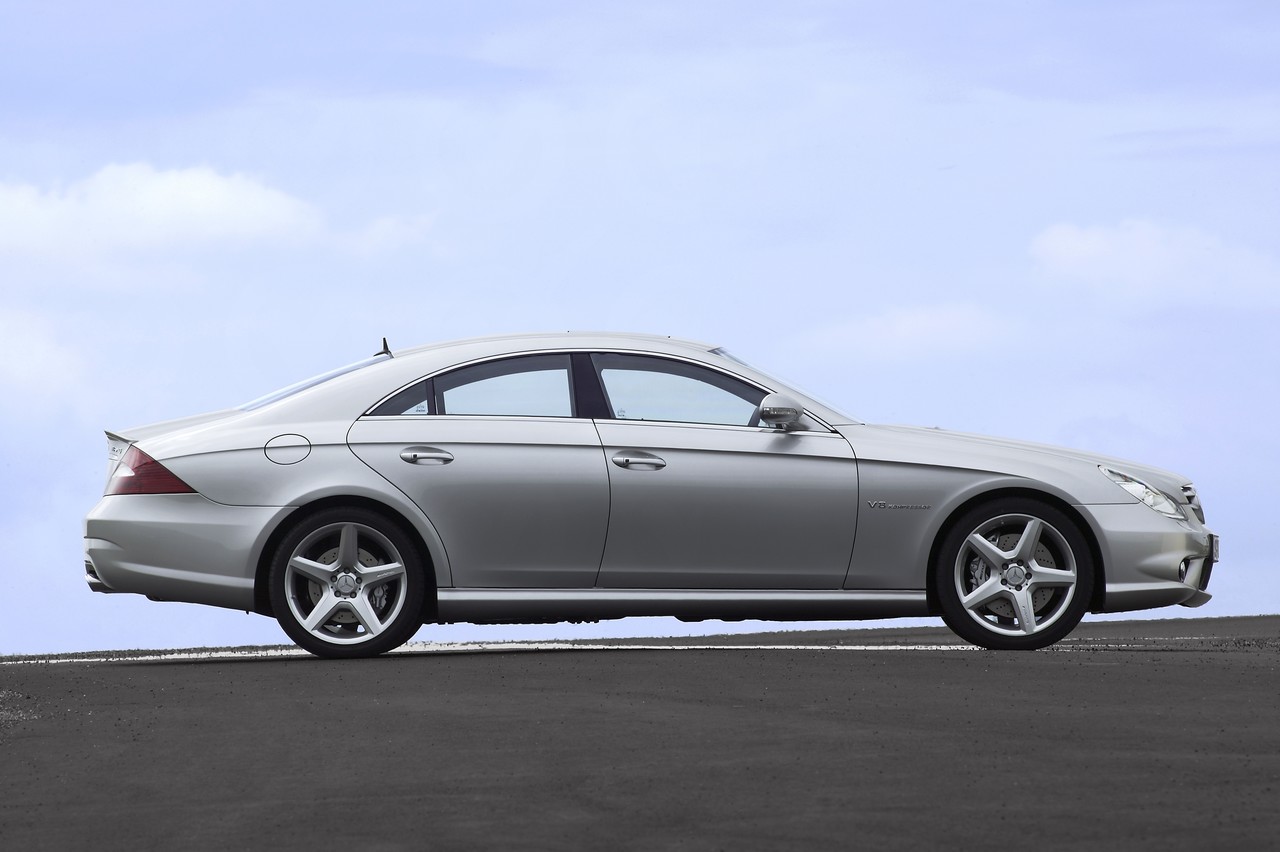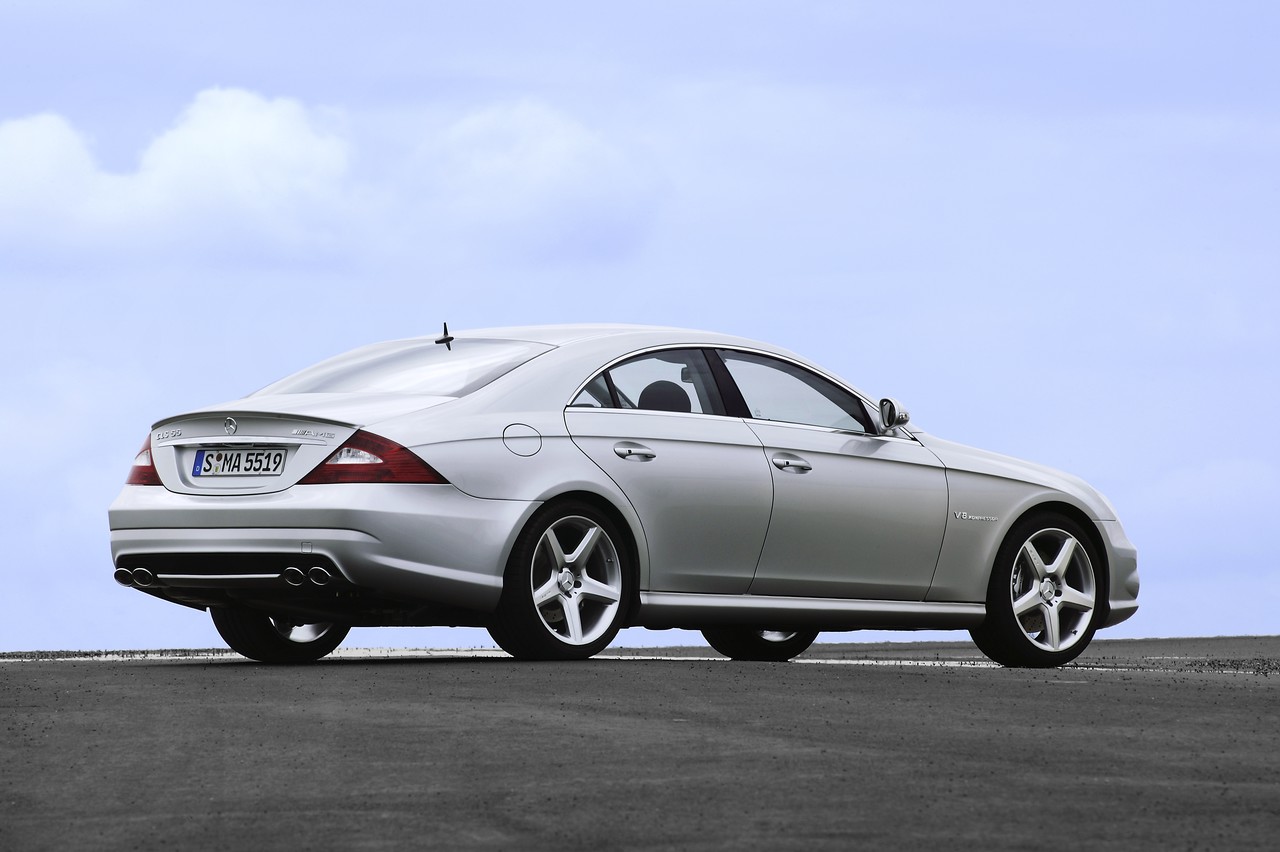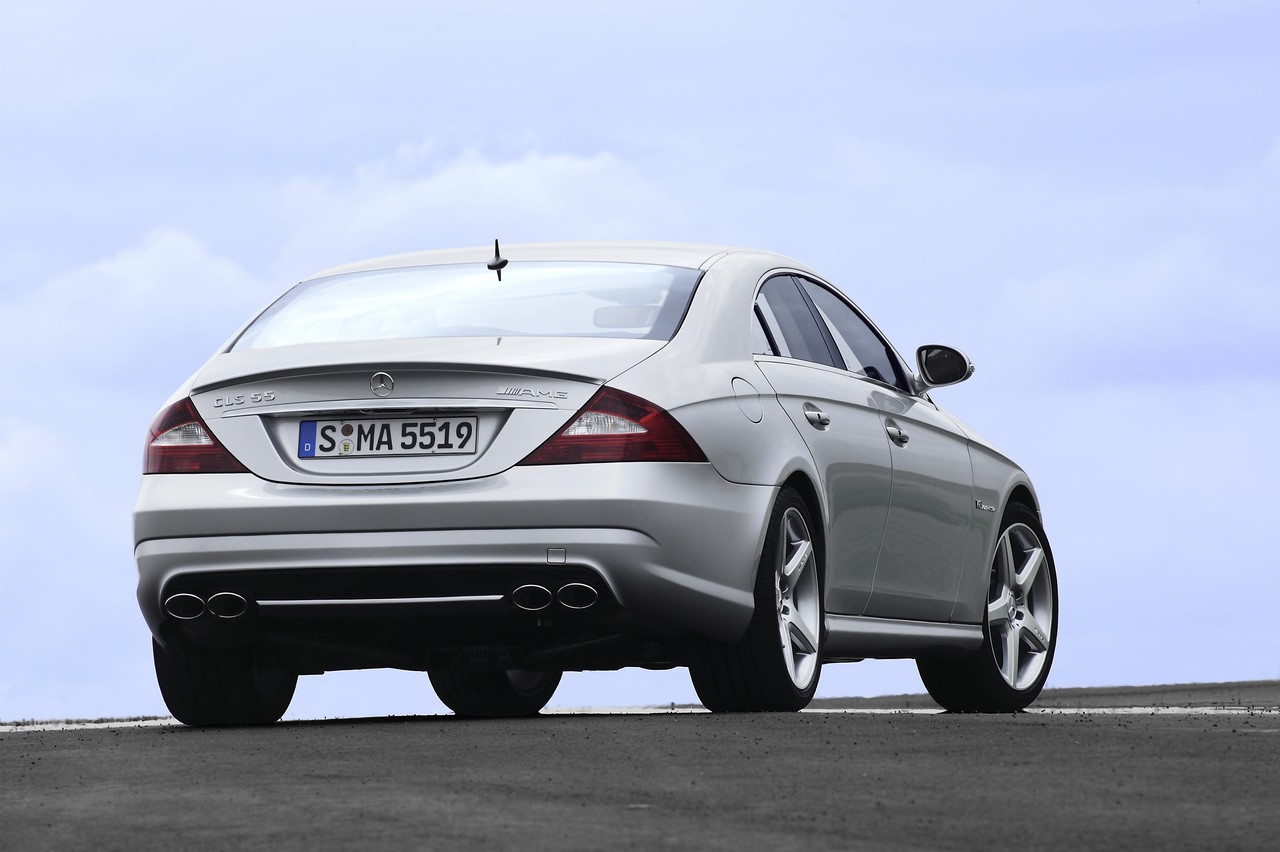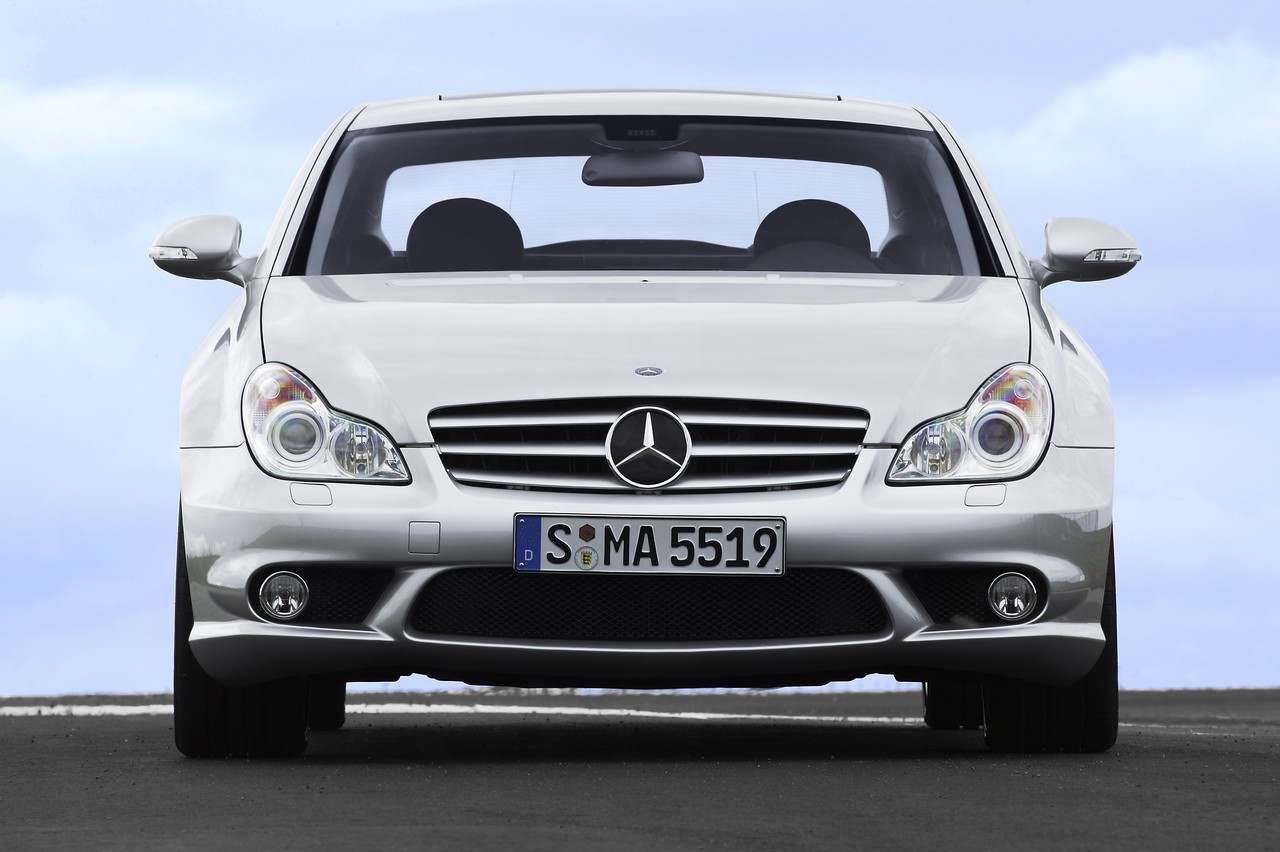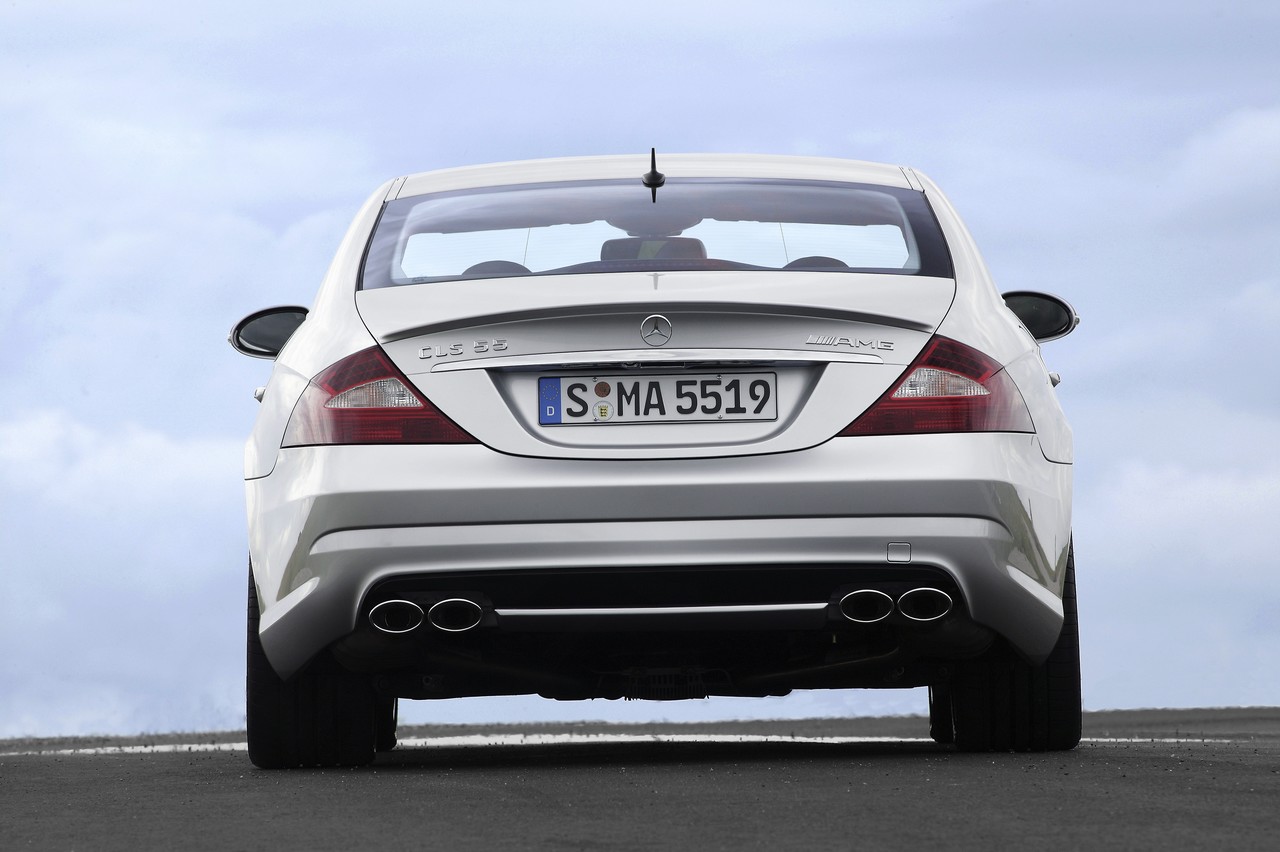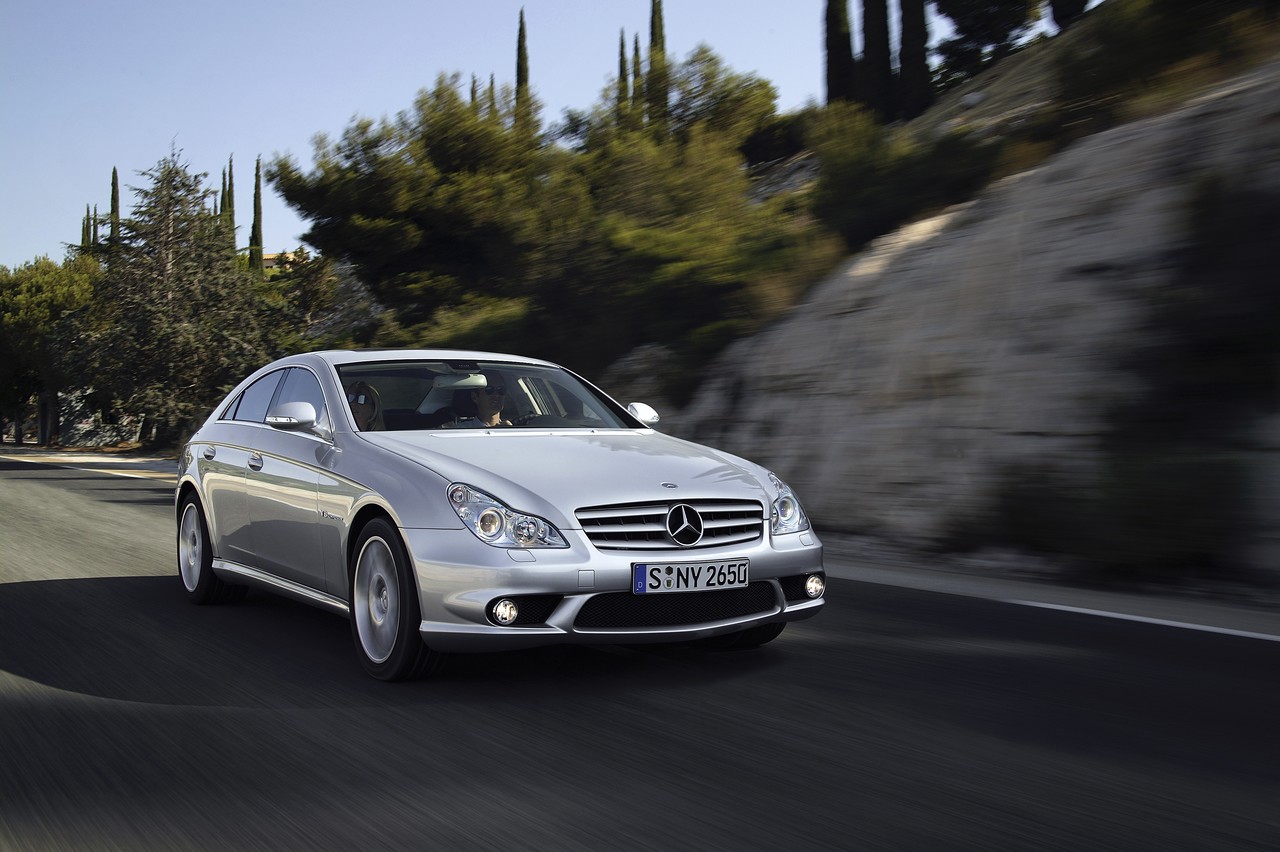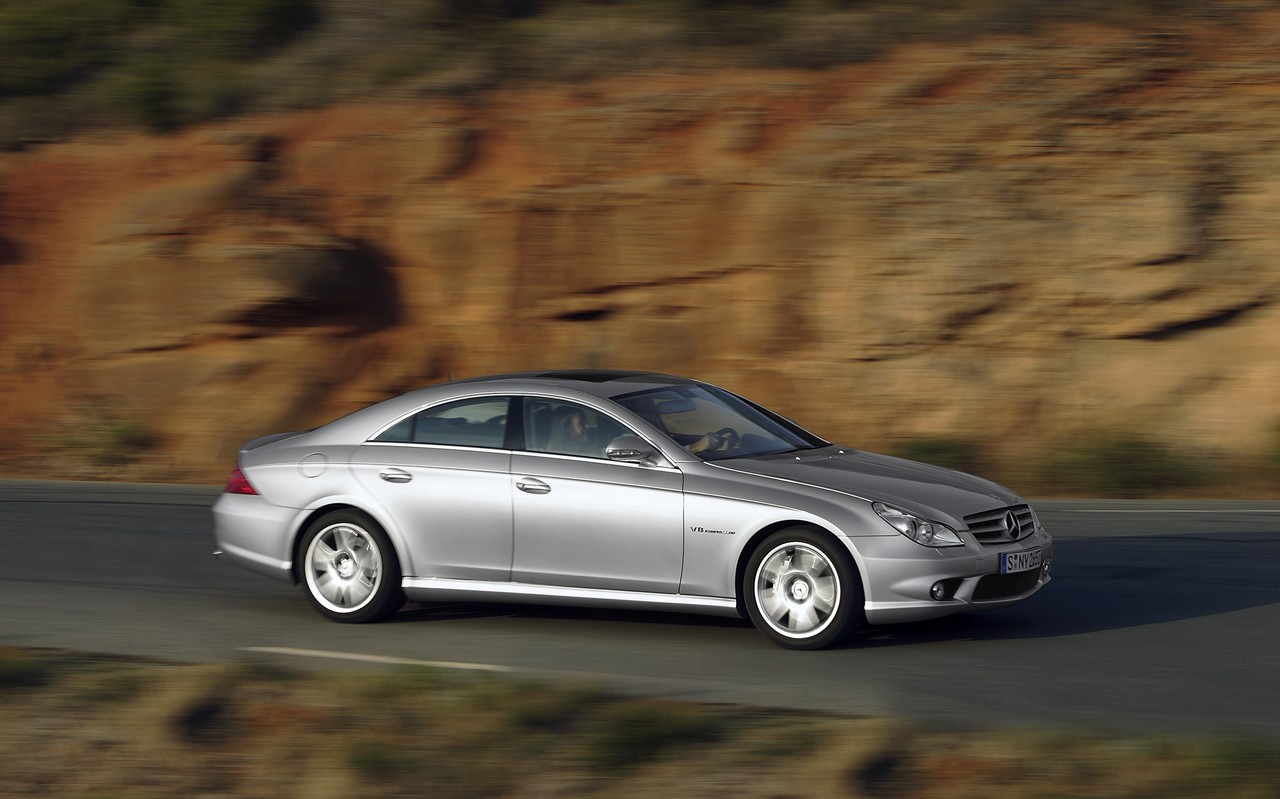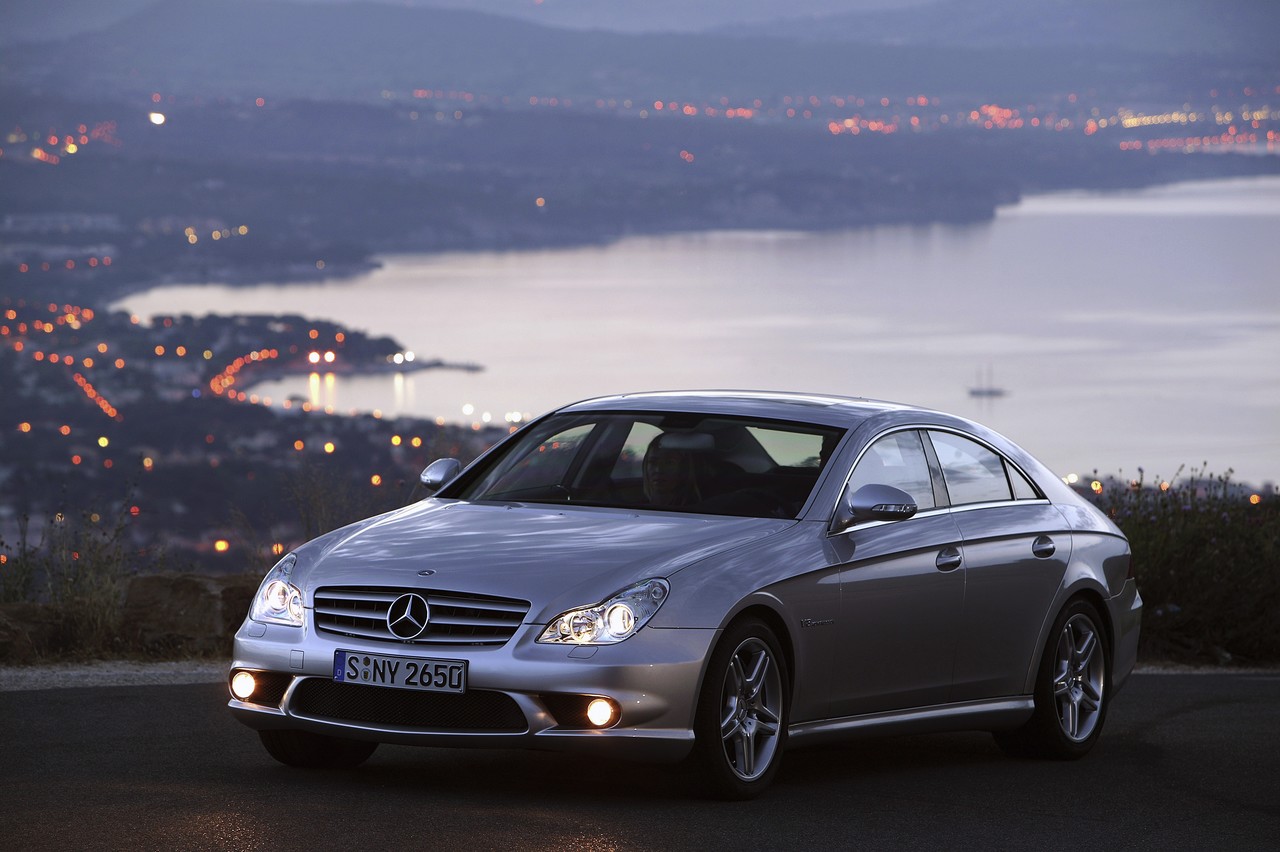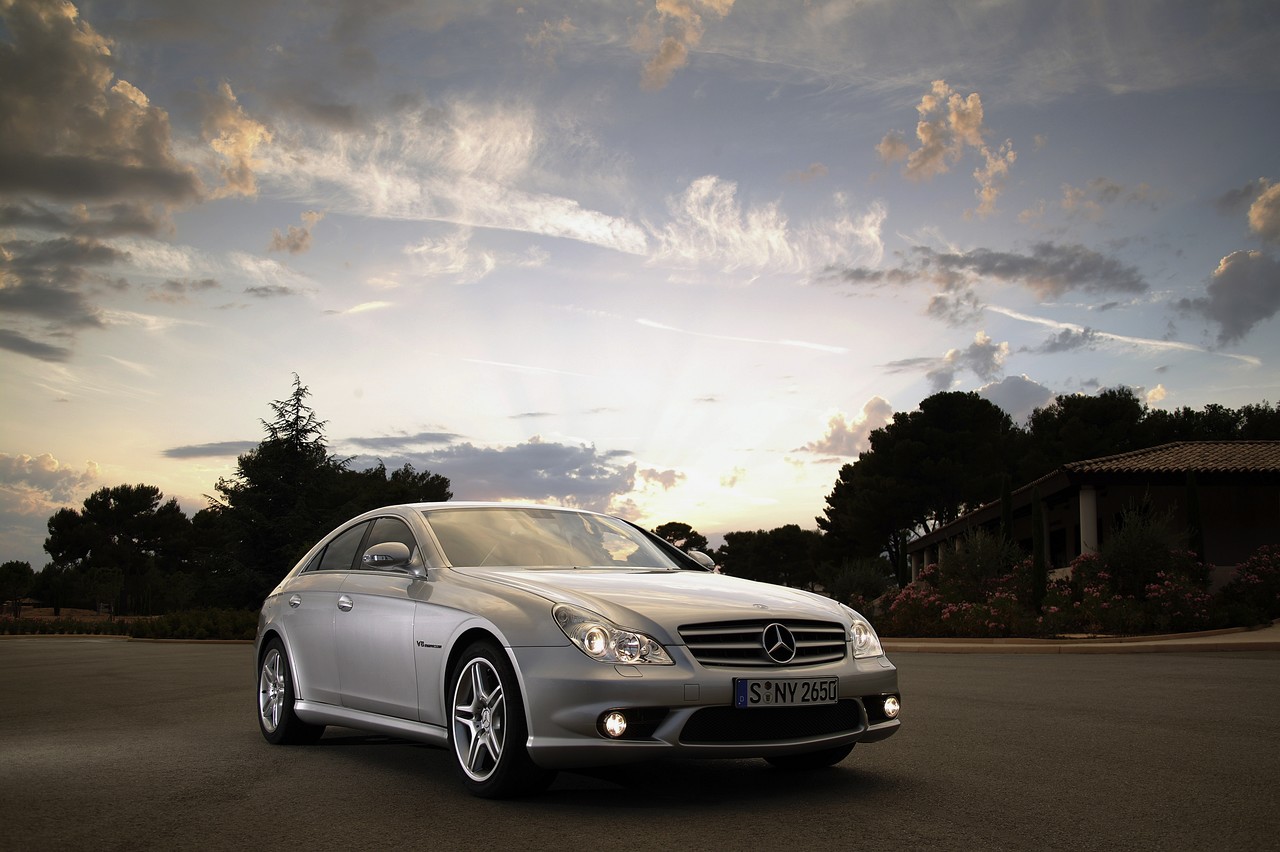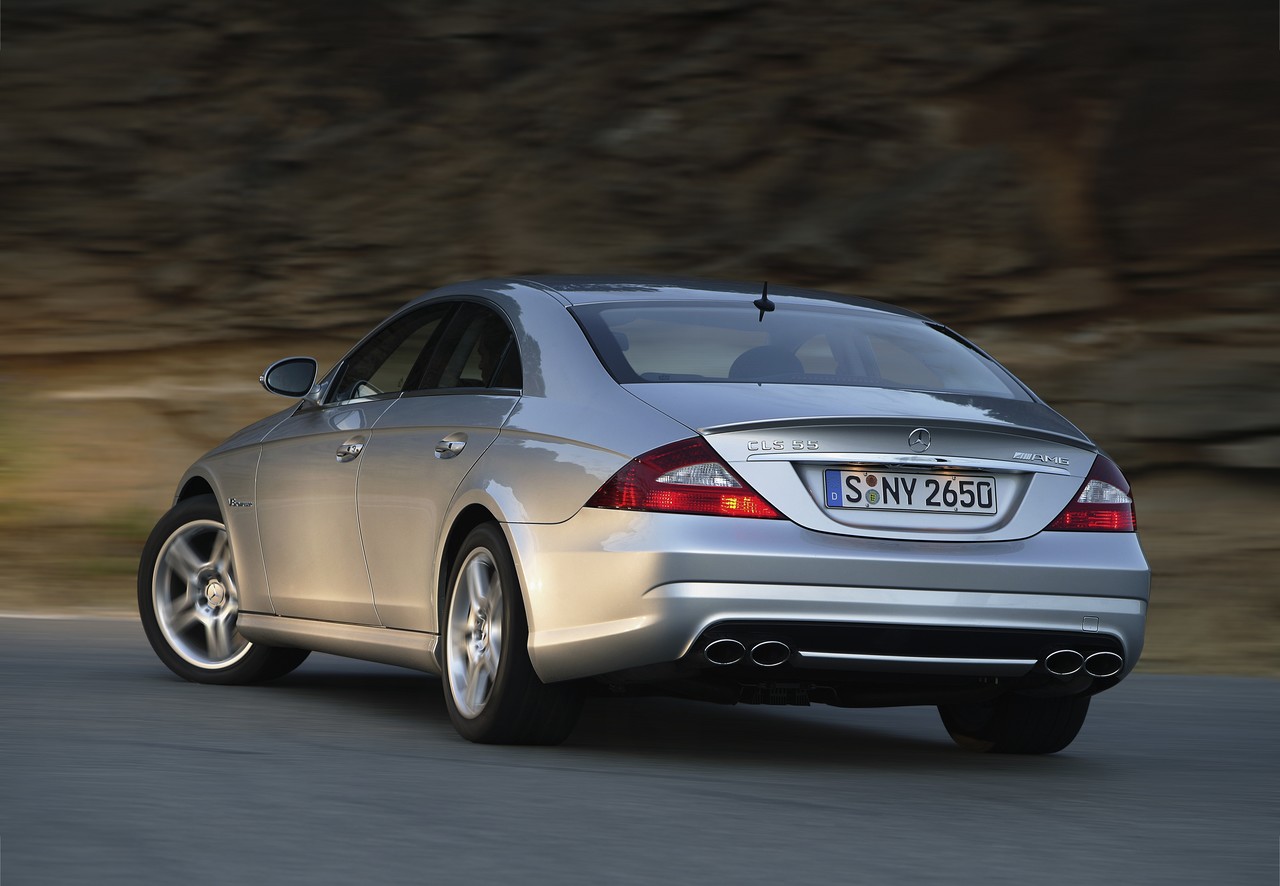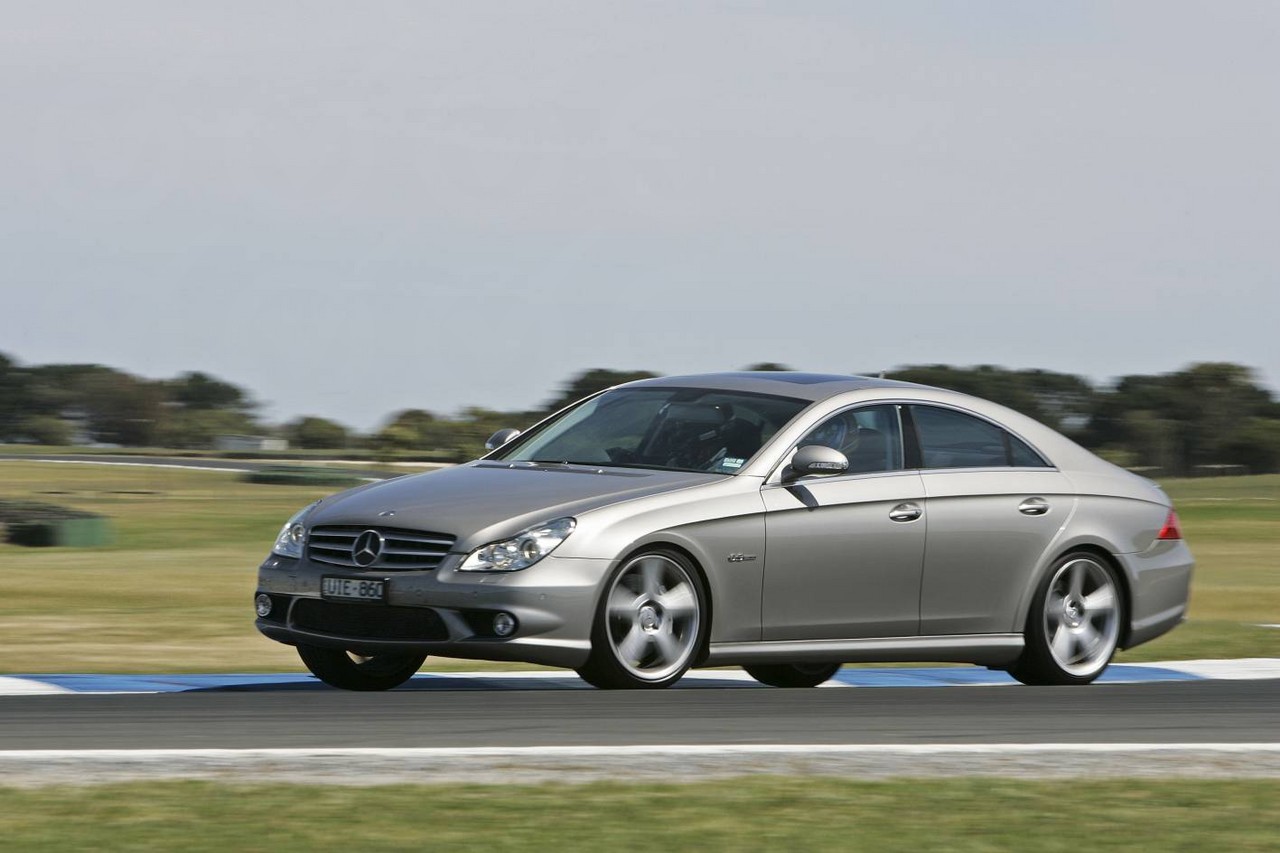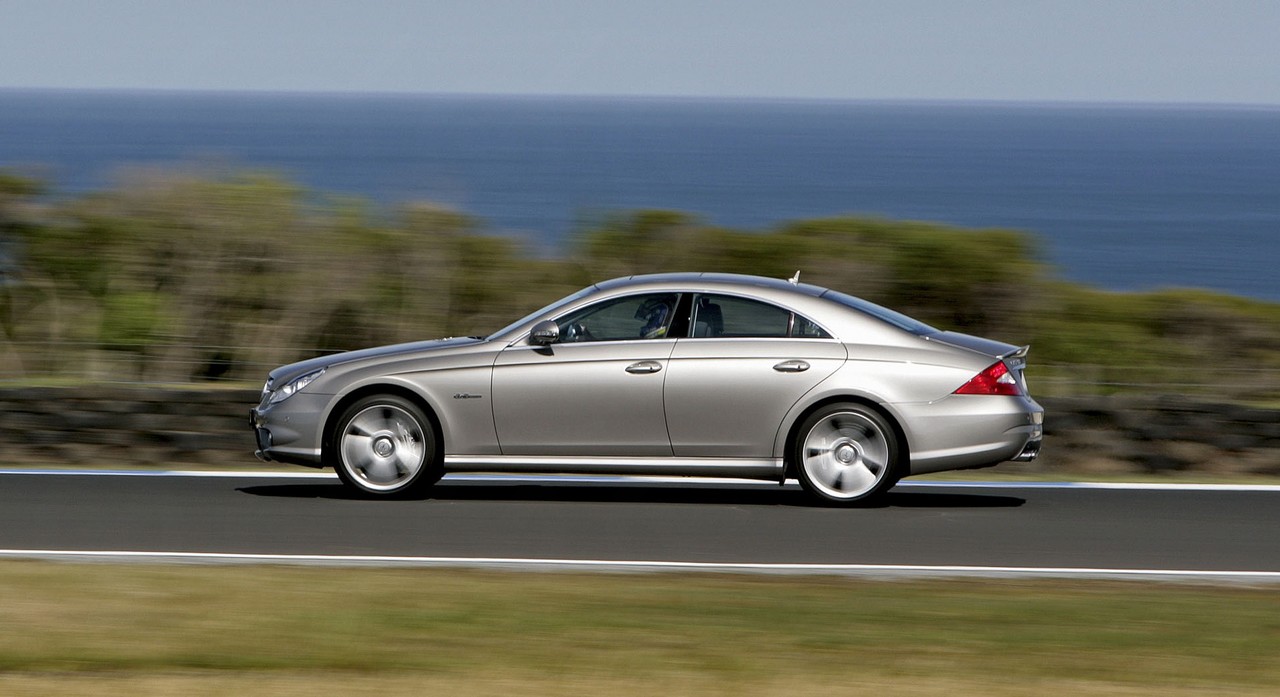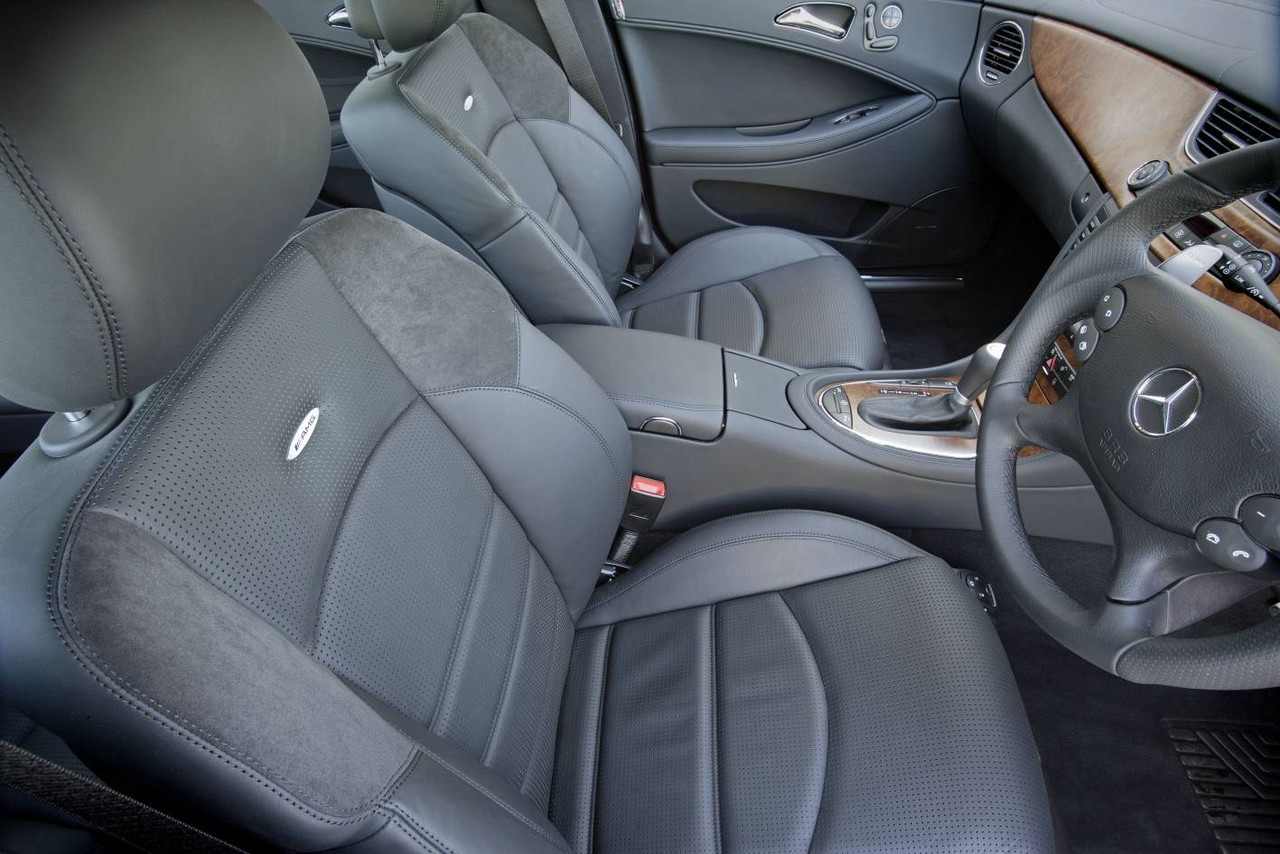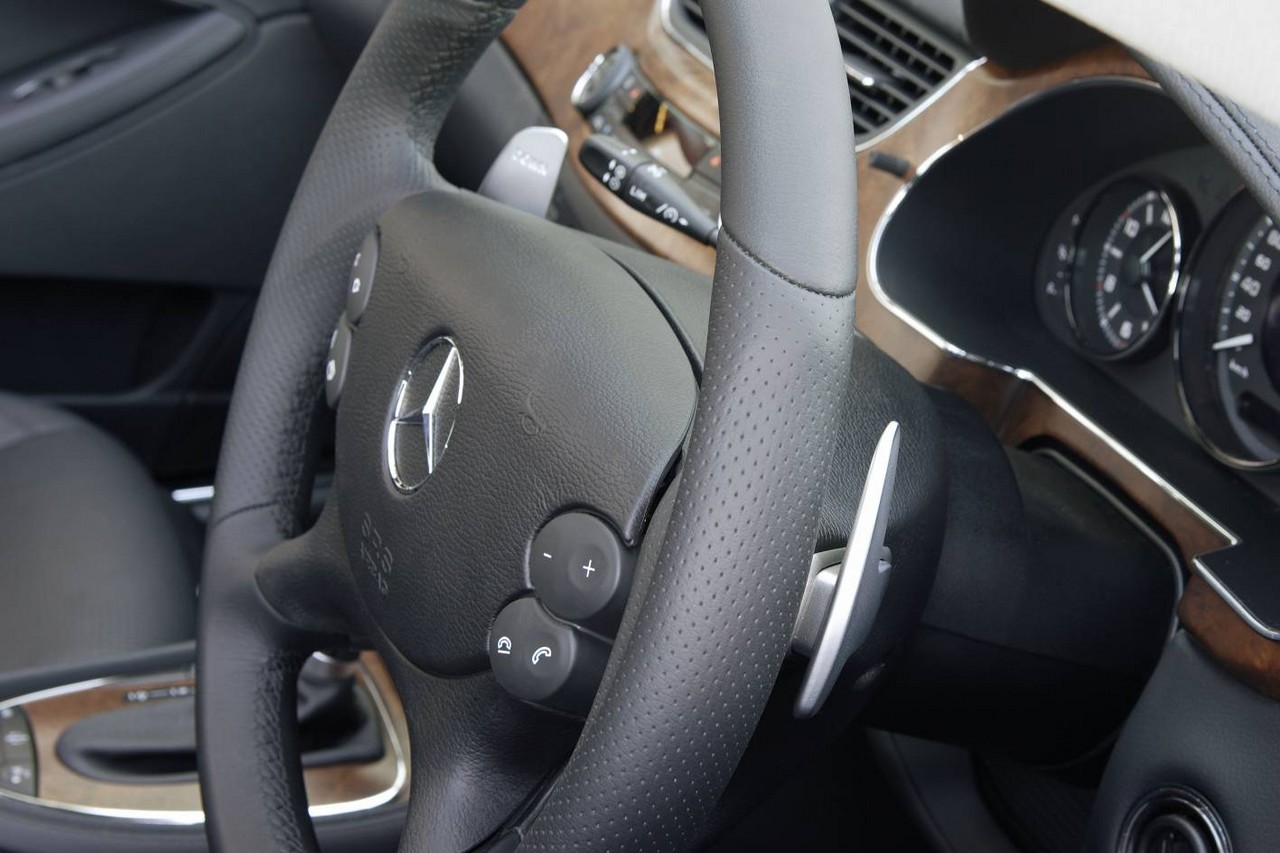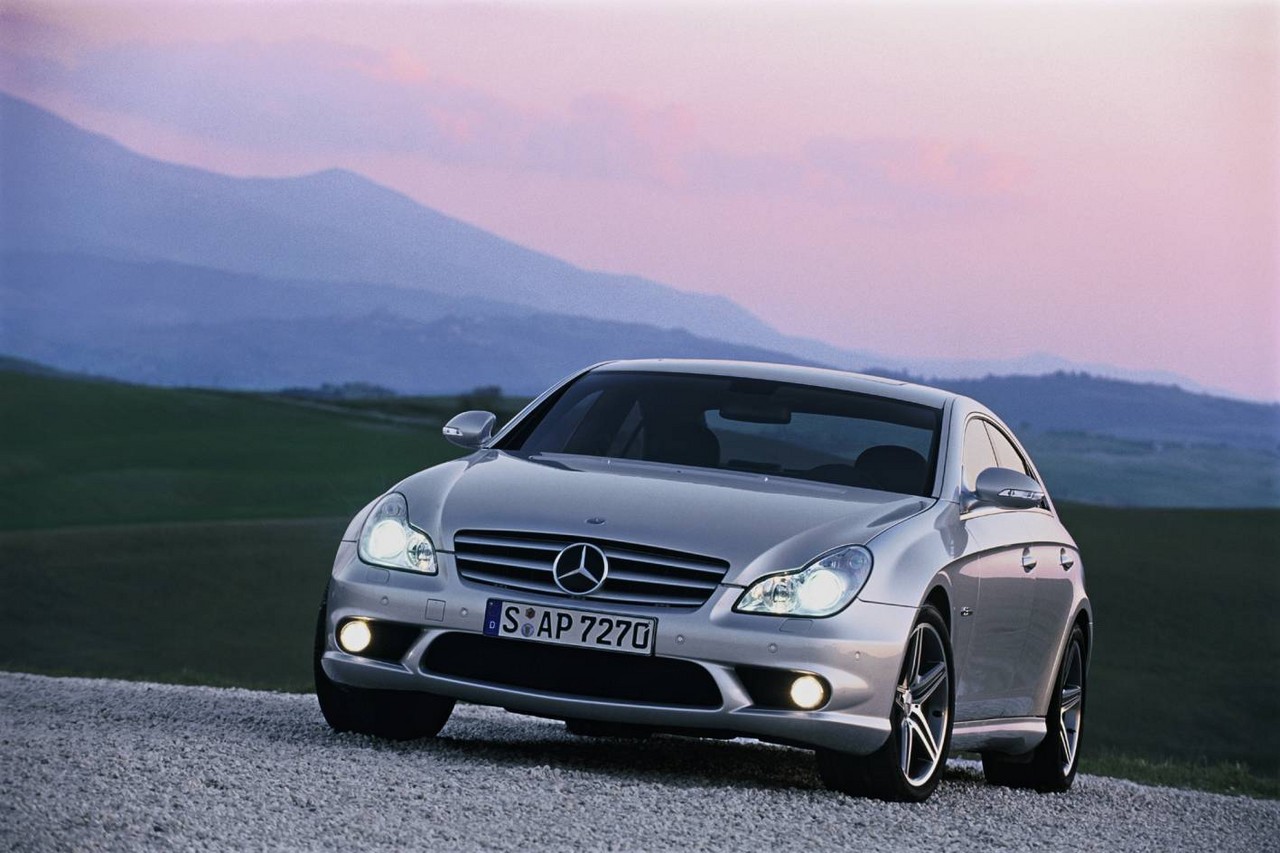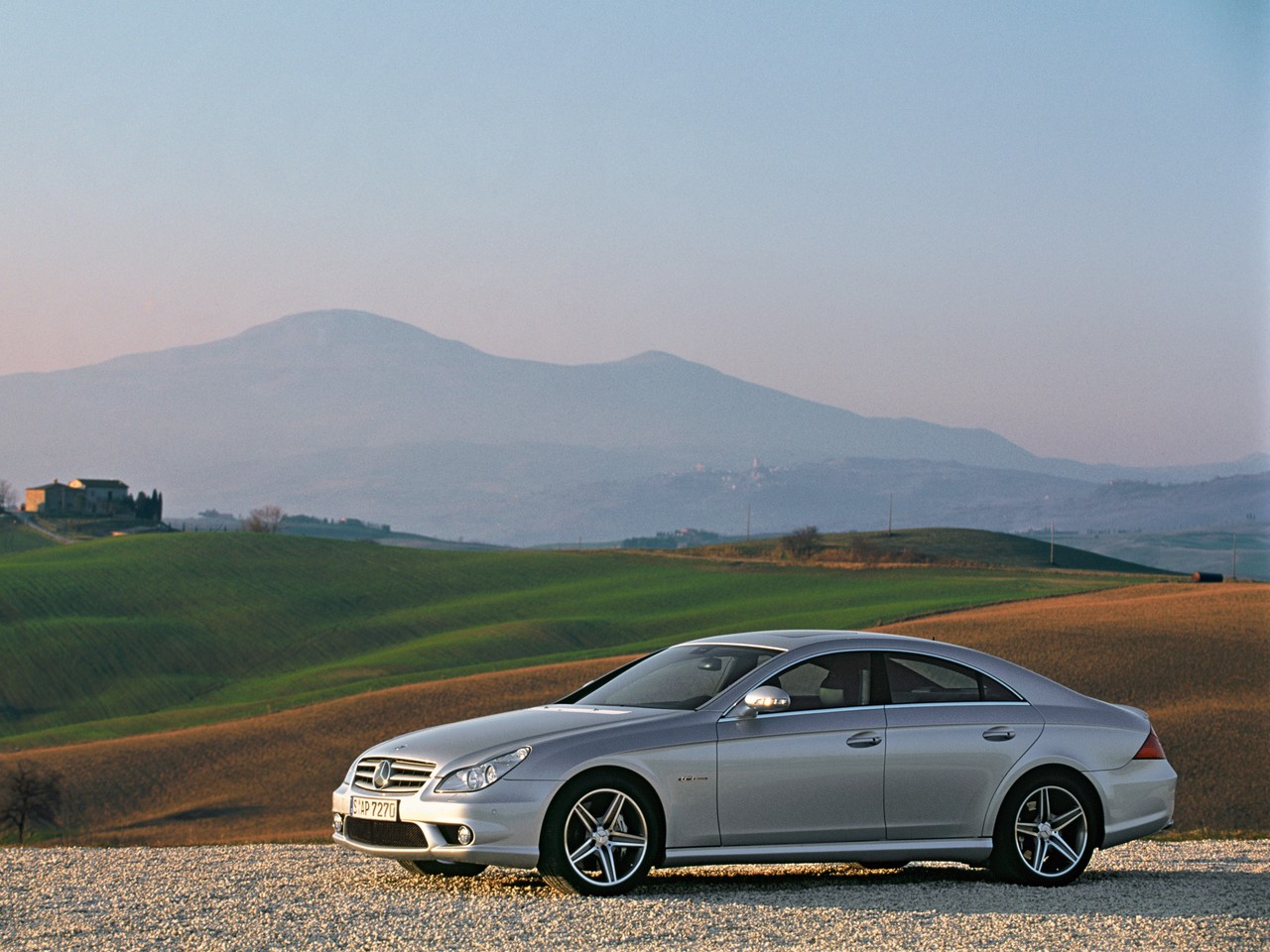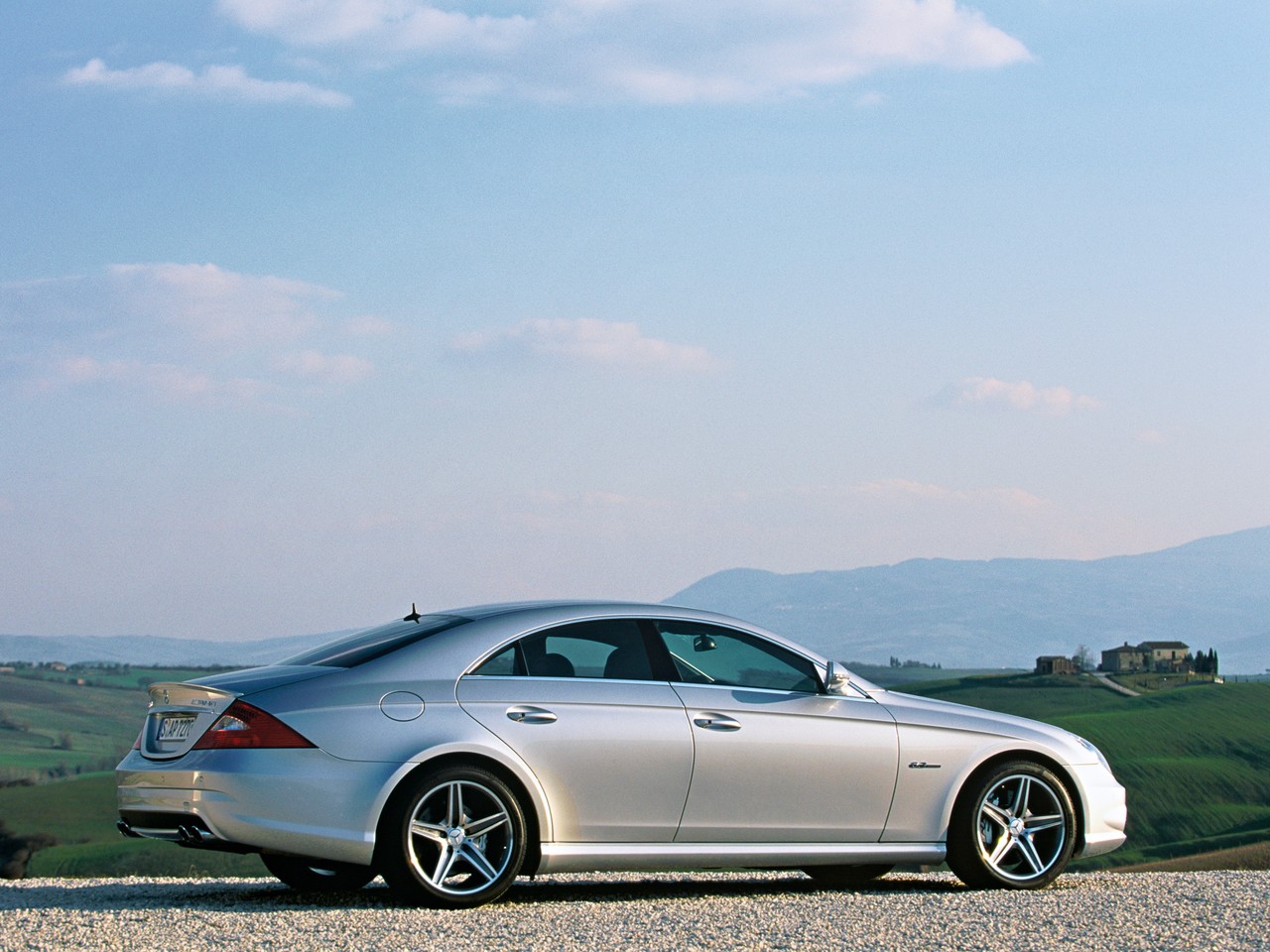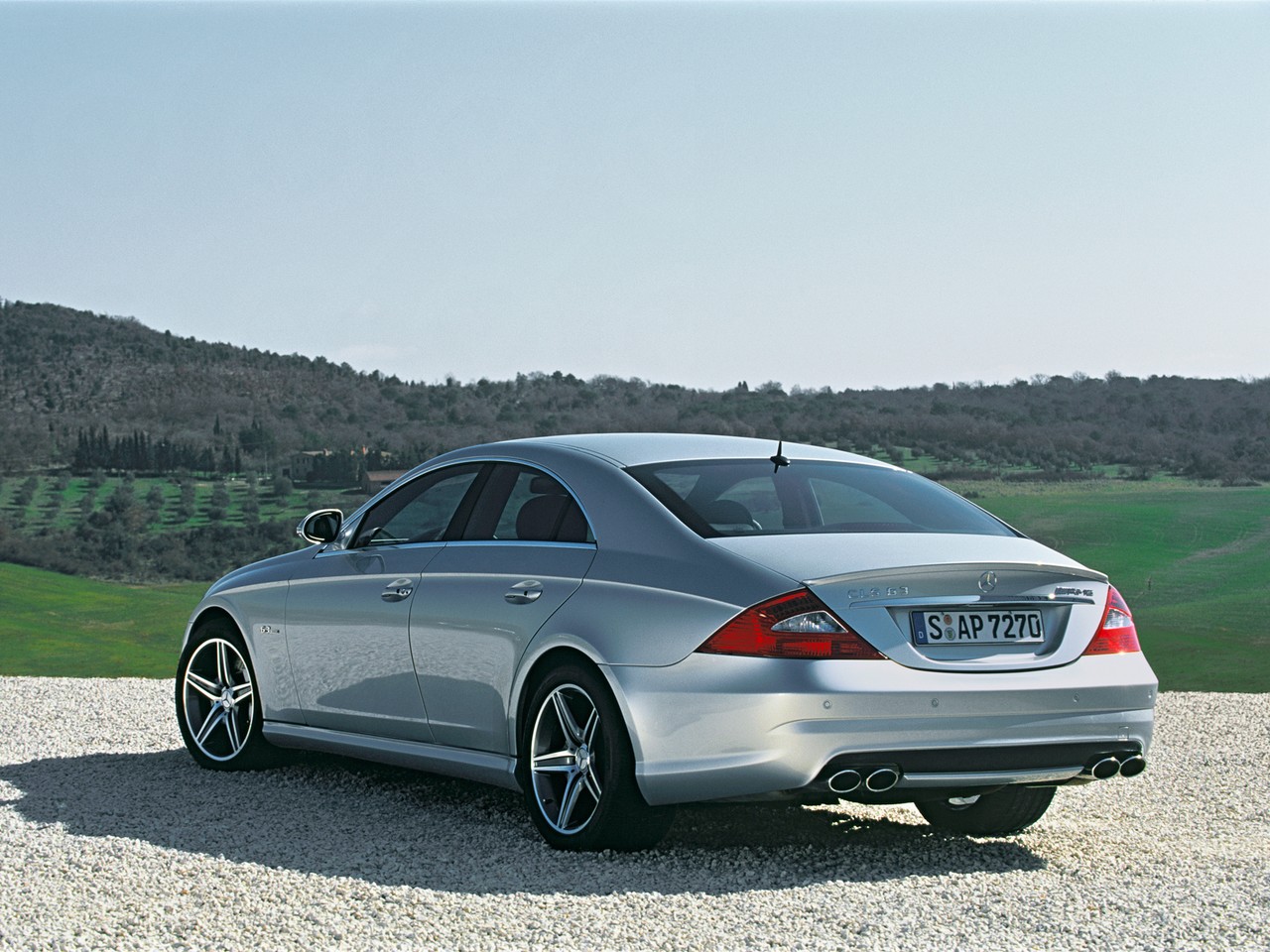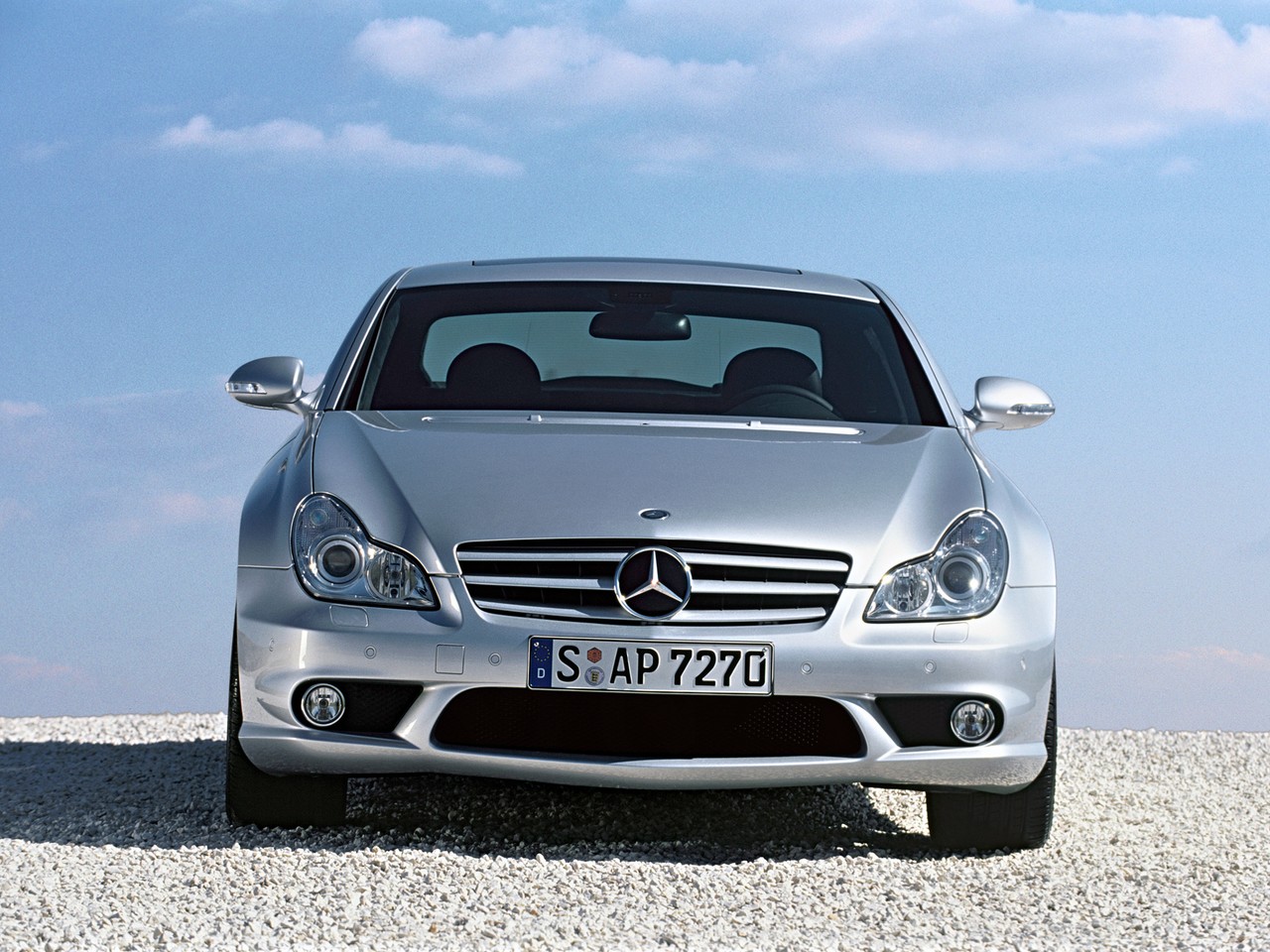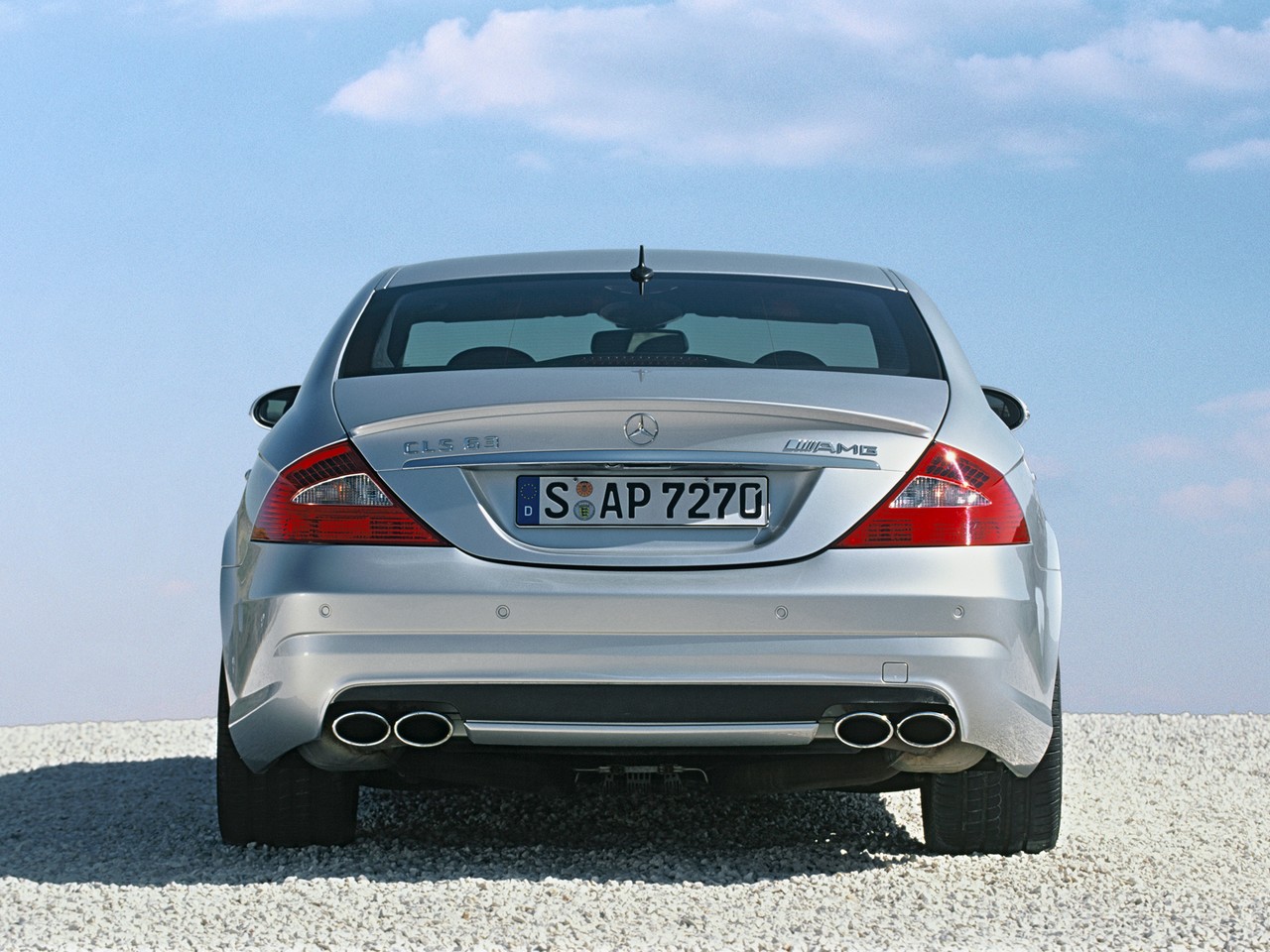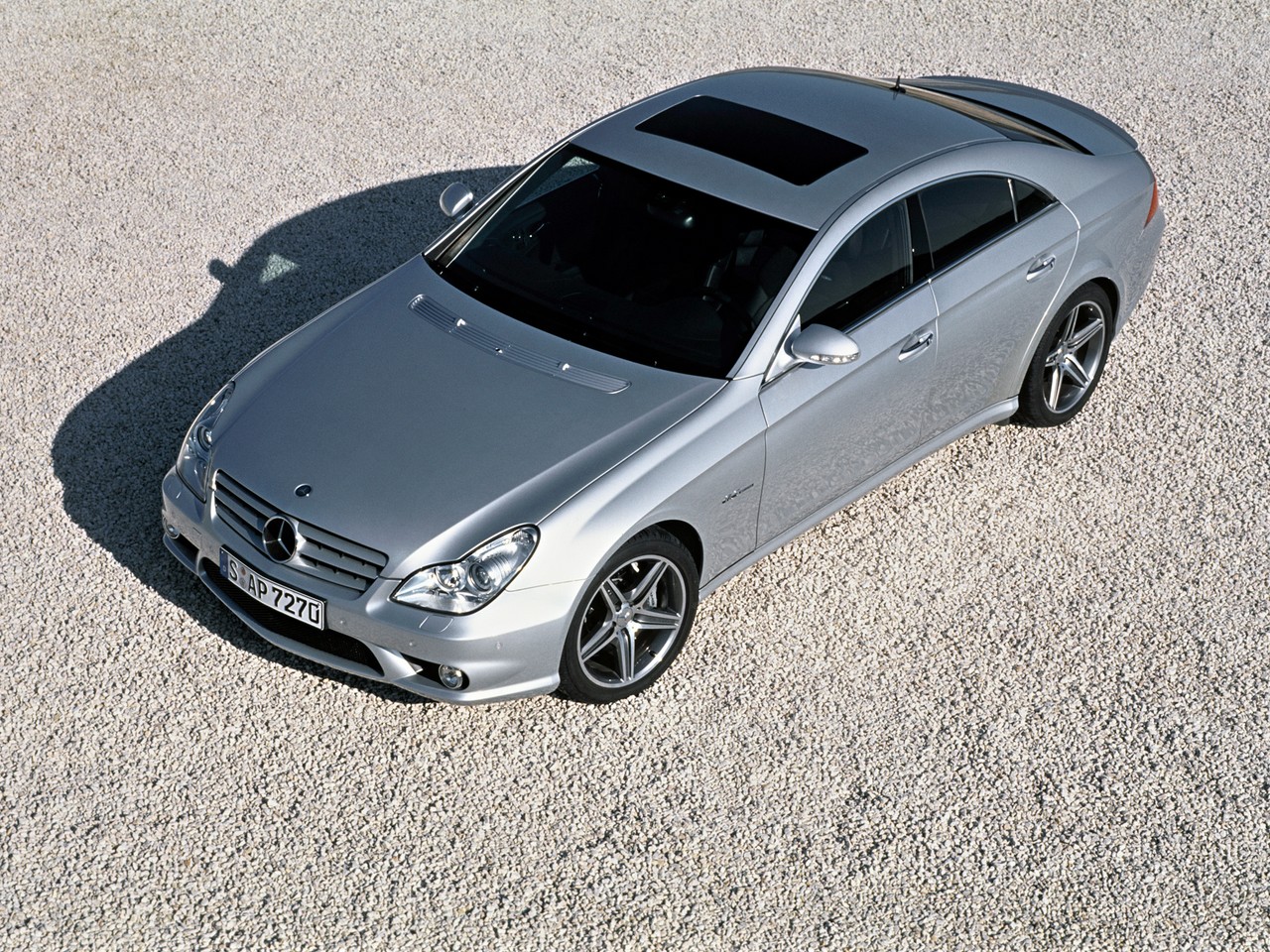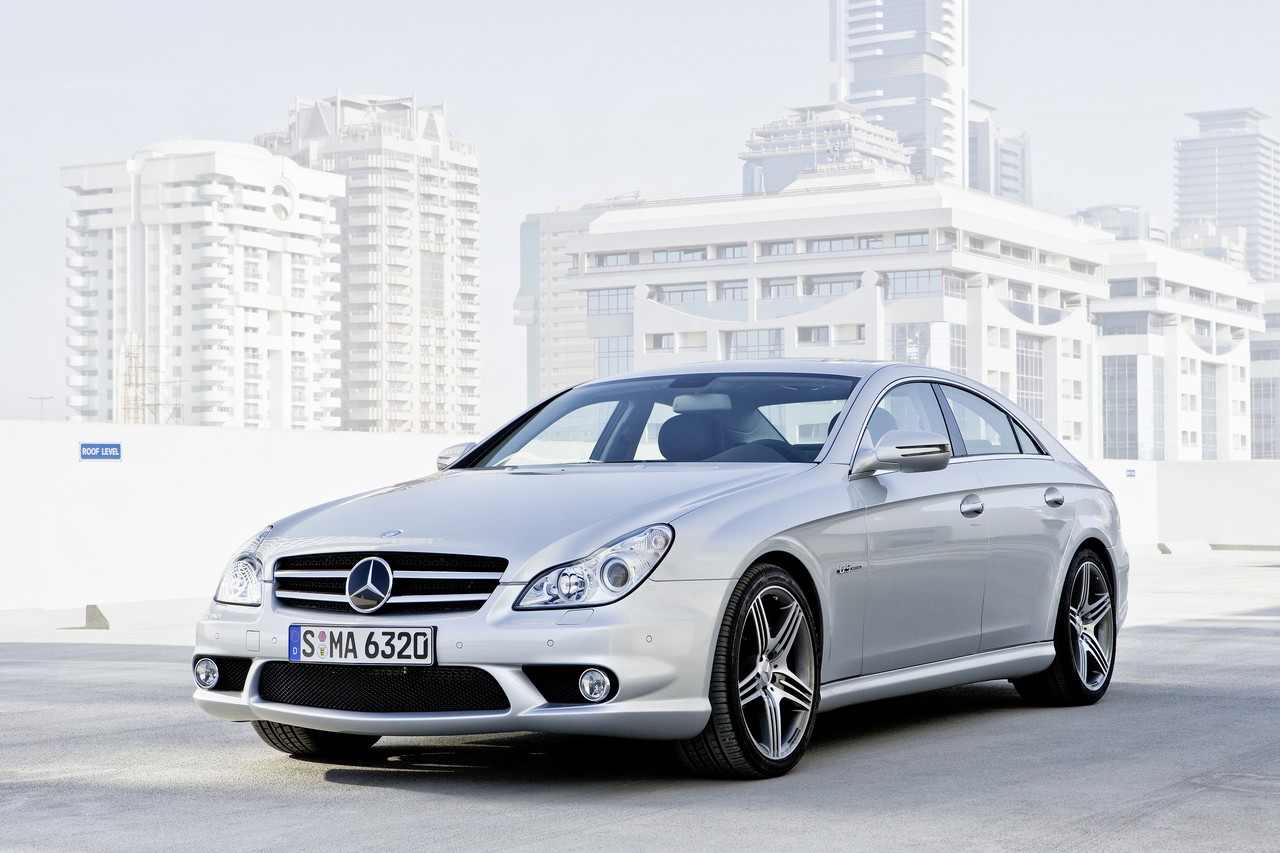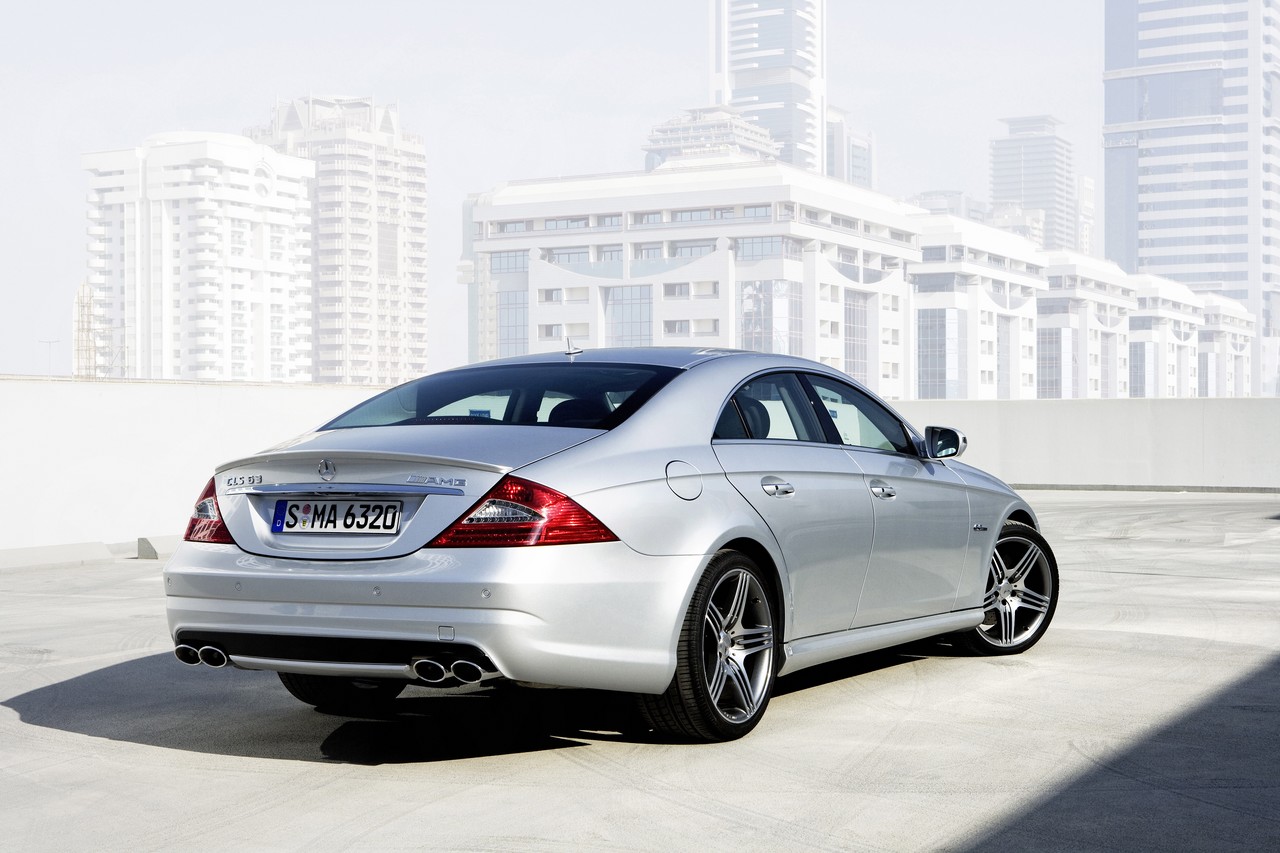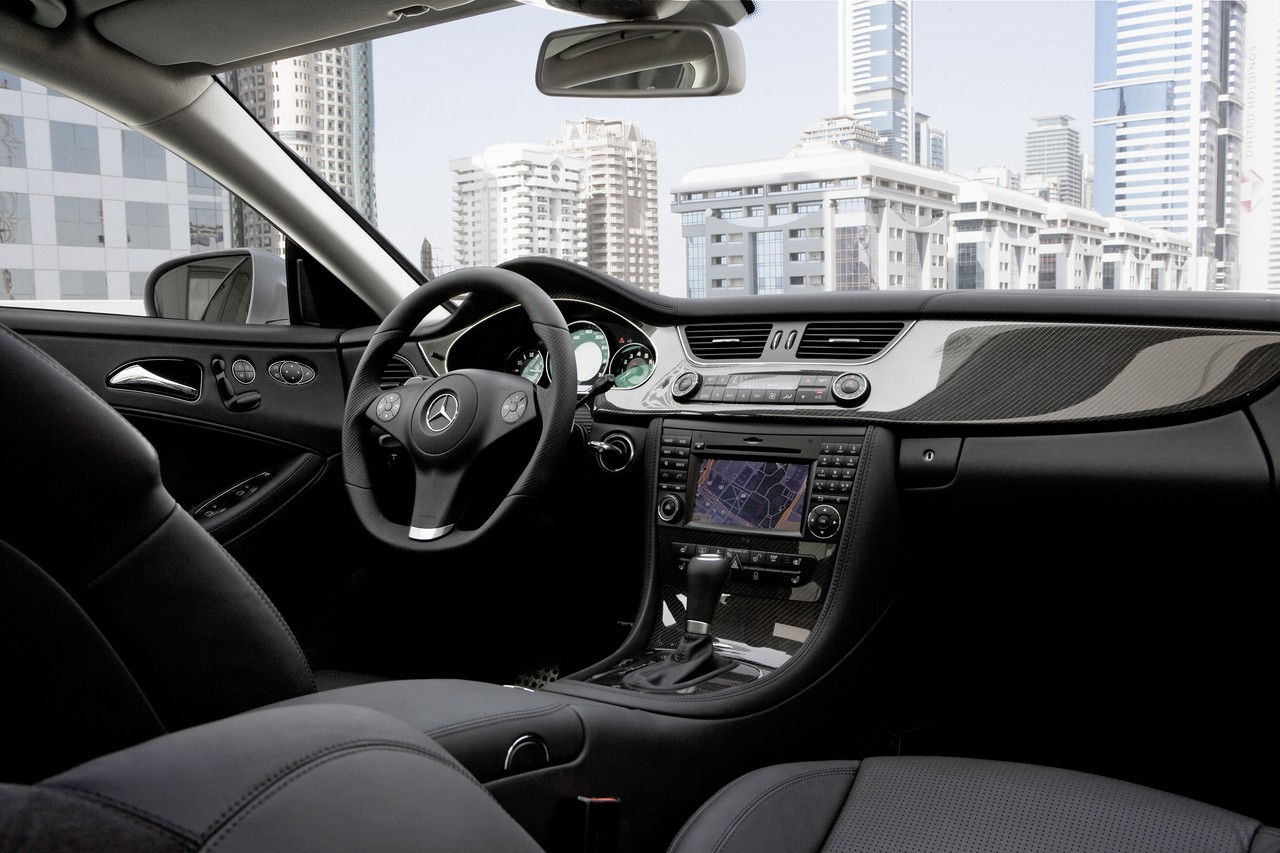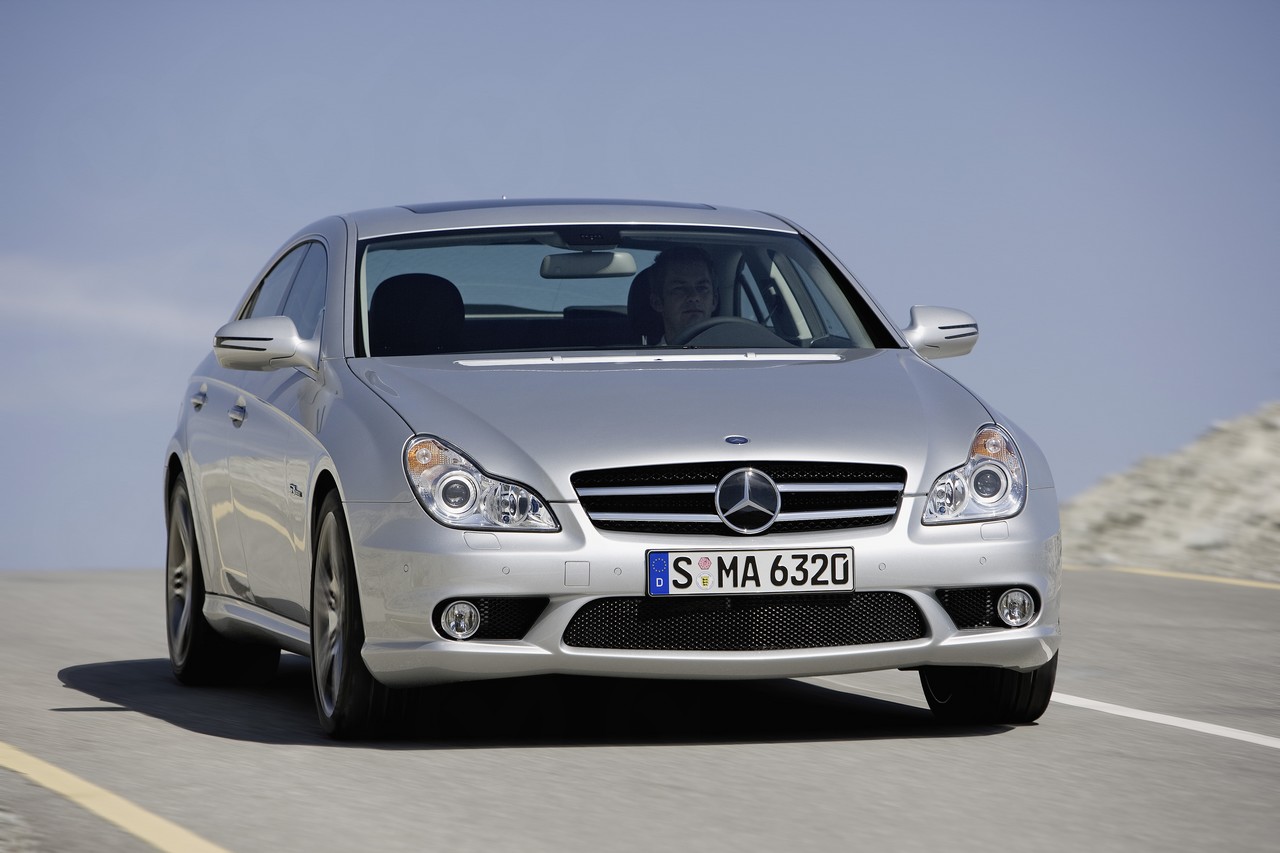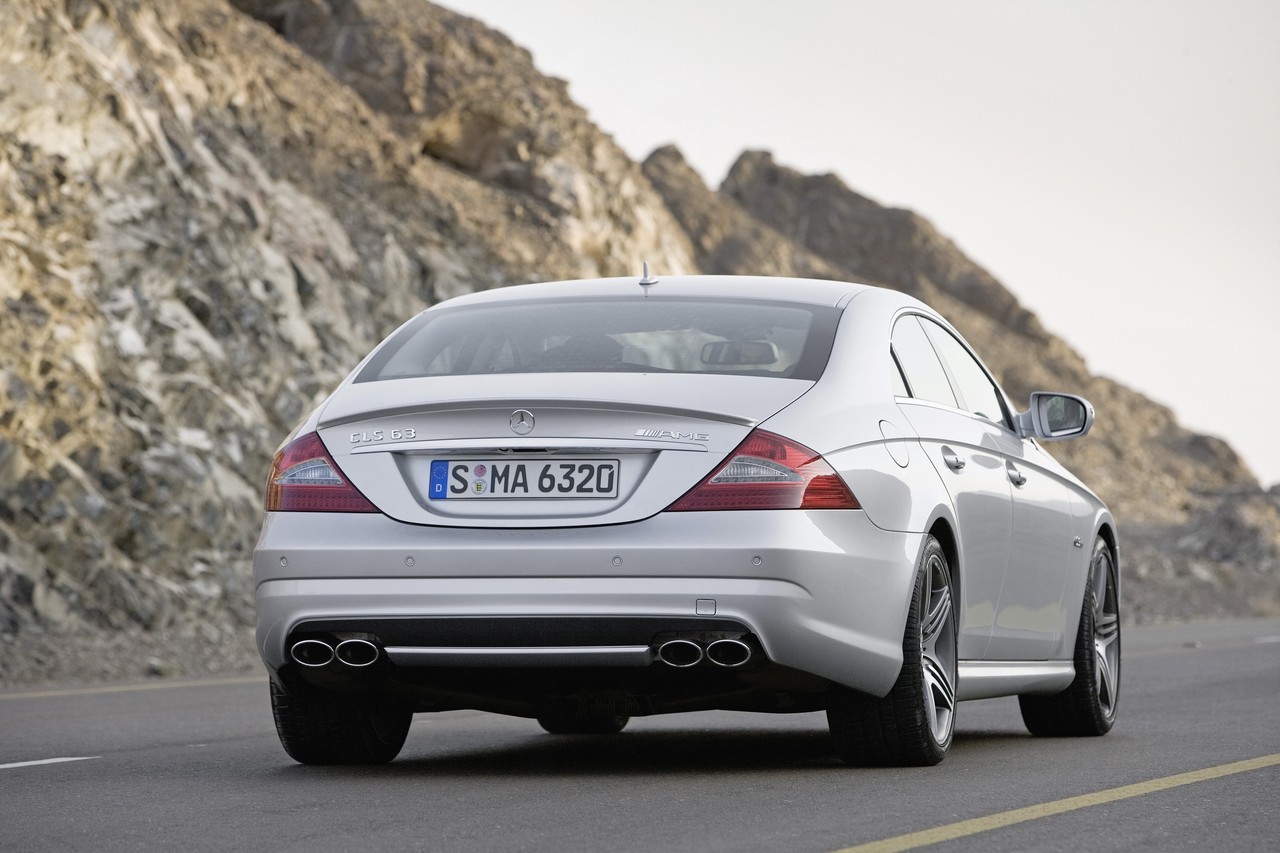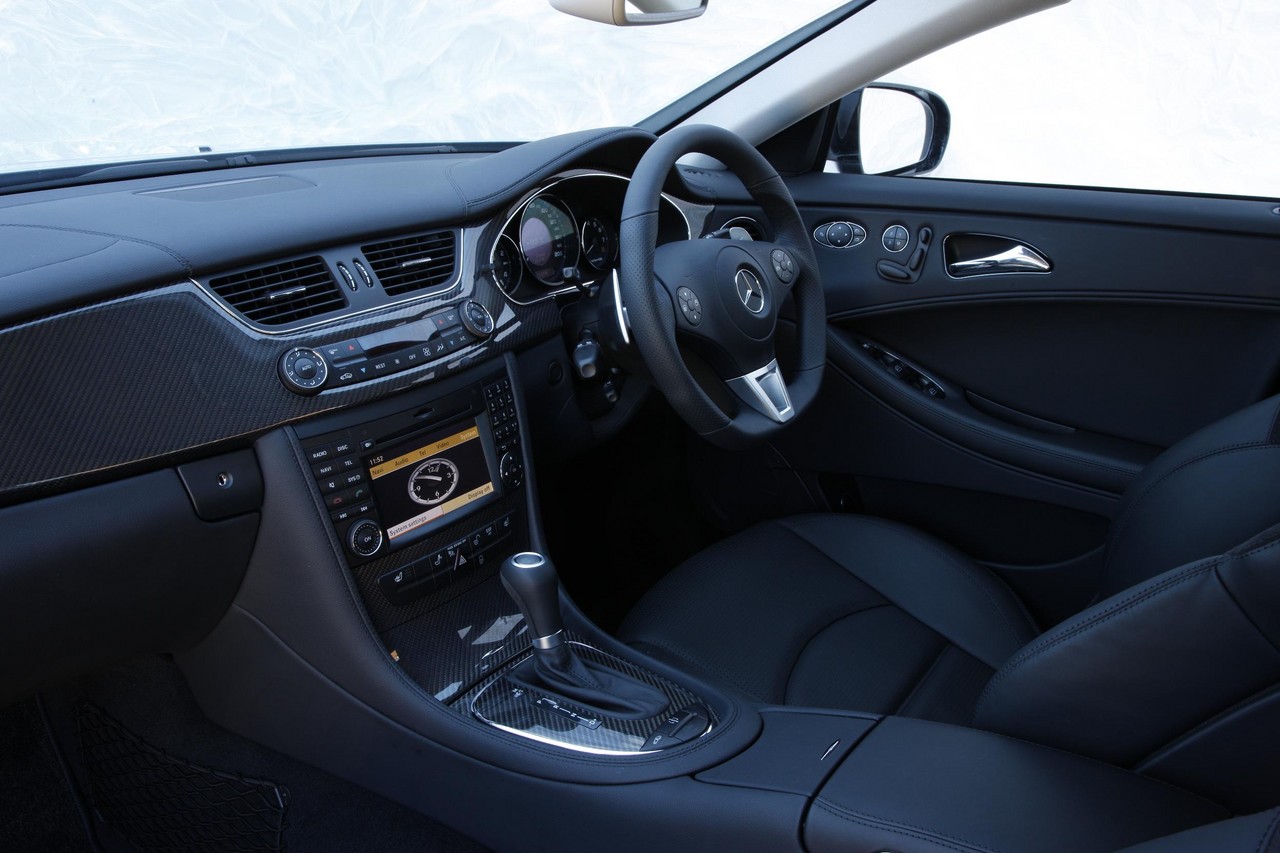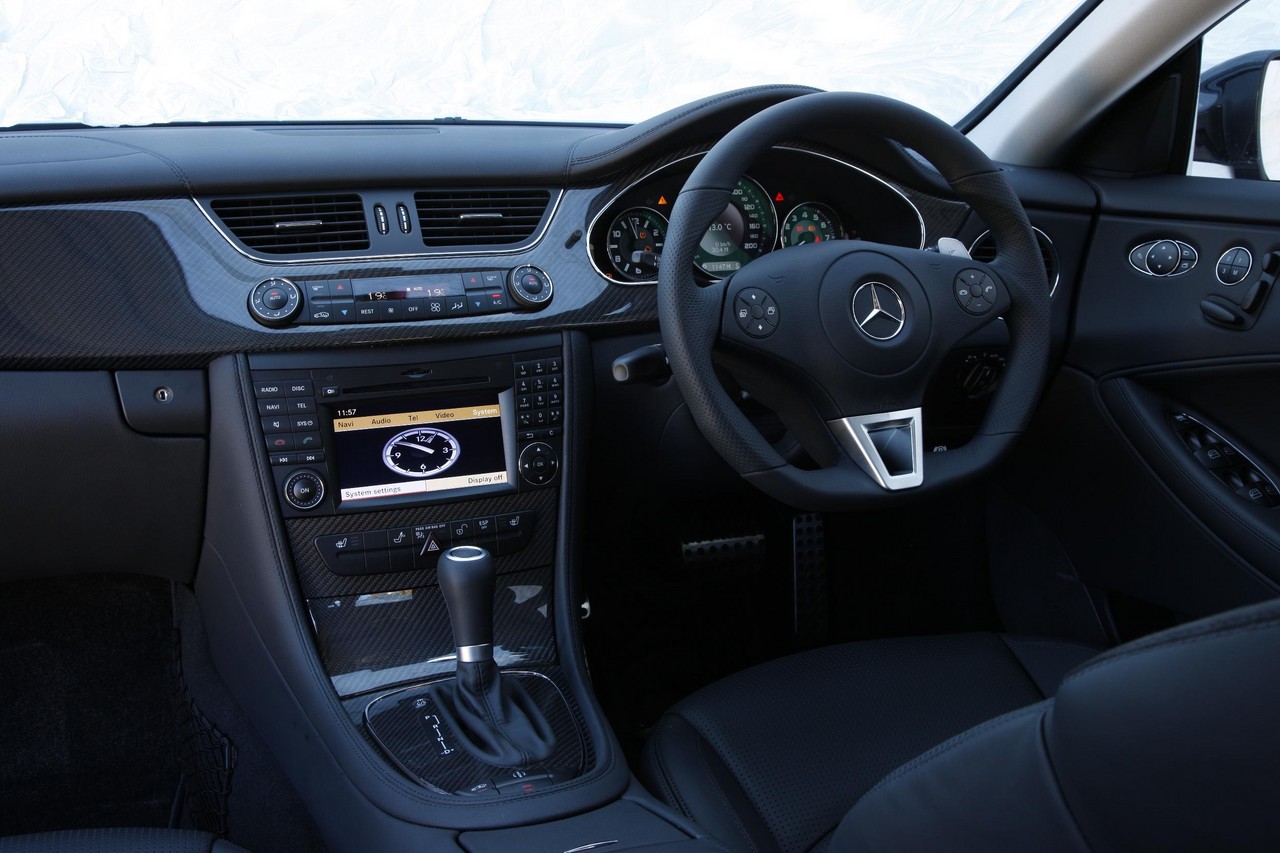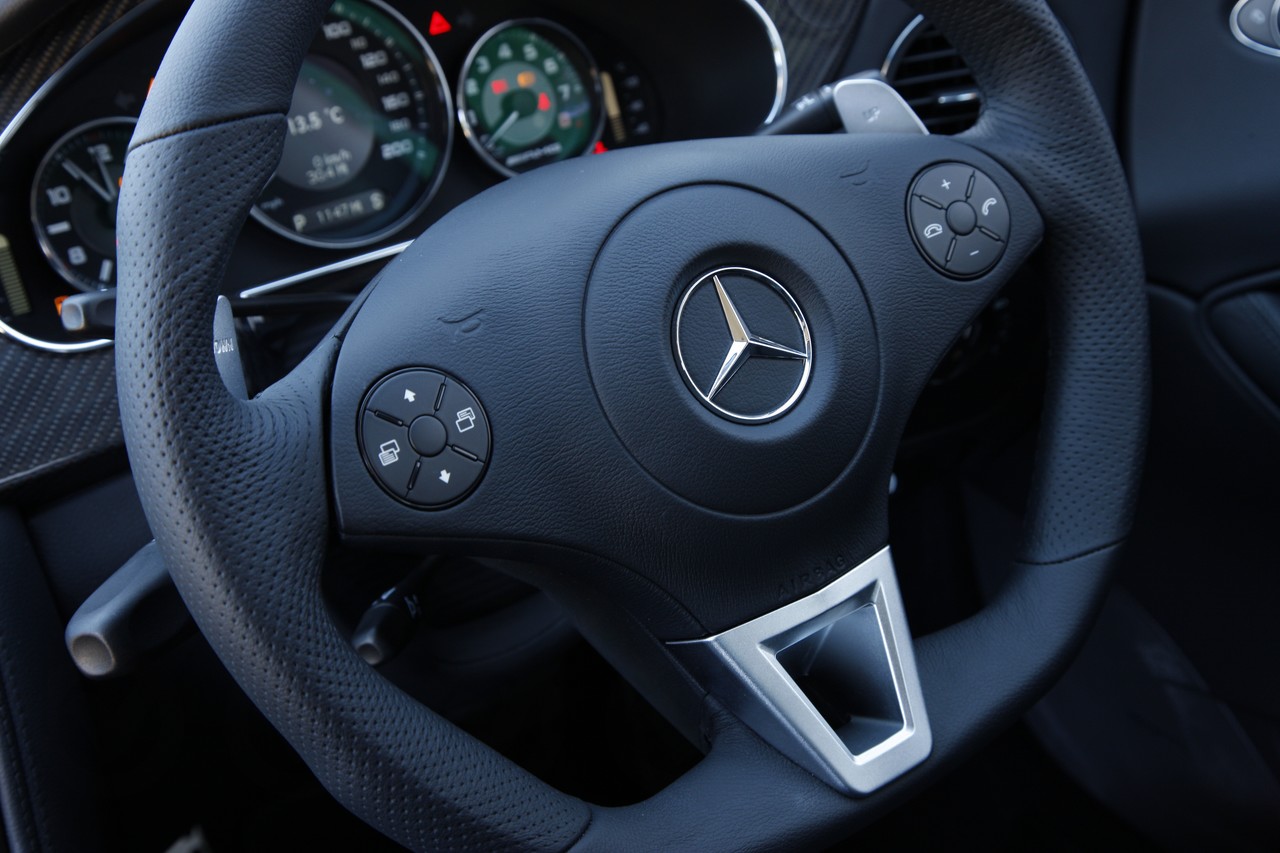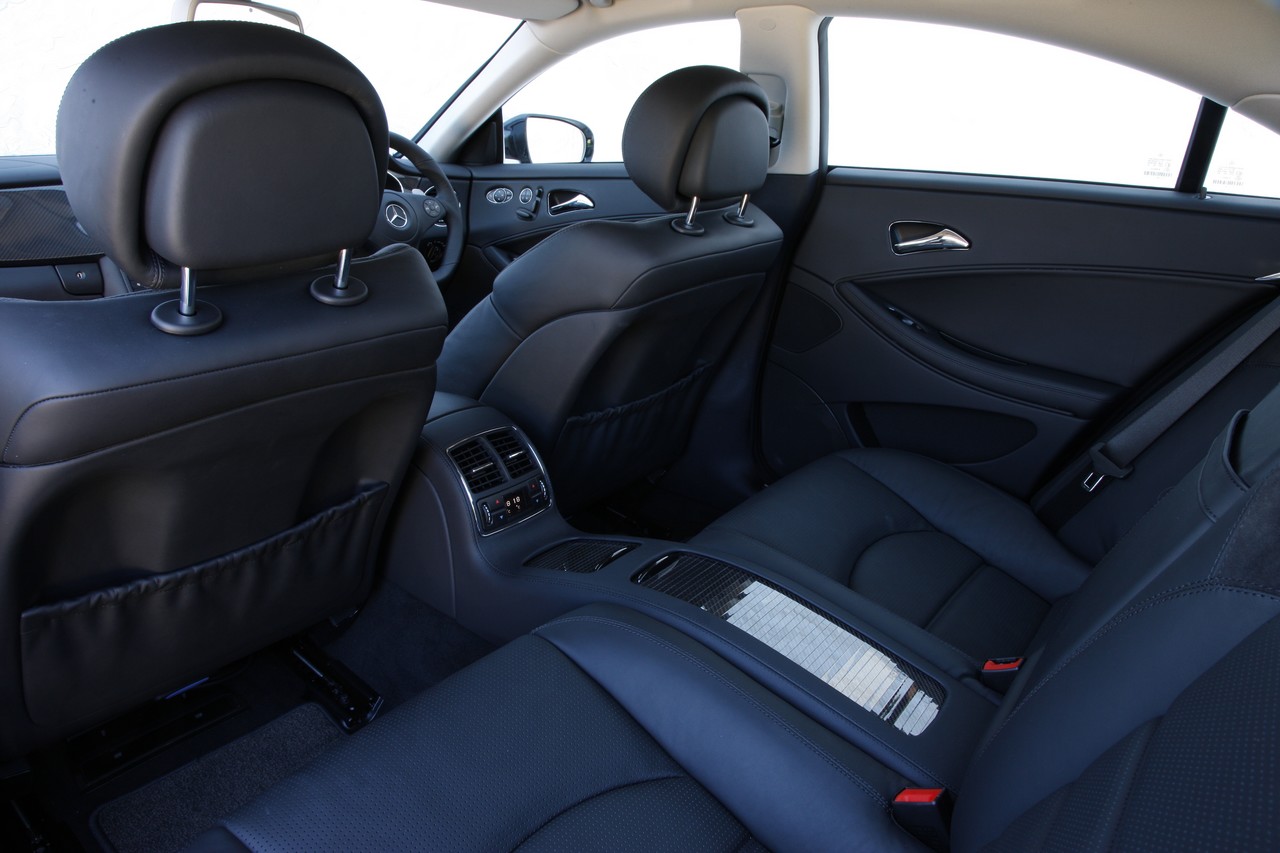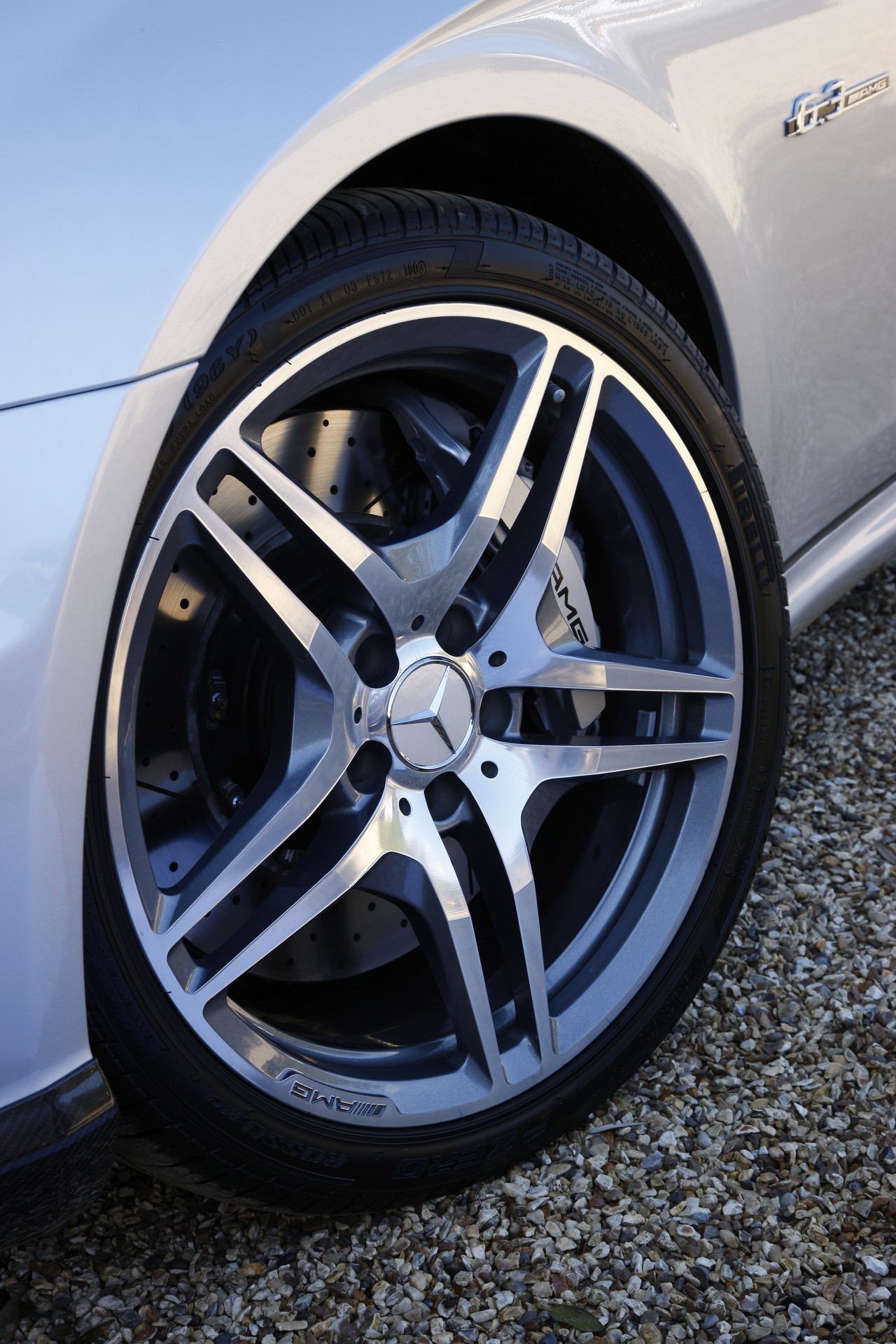
- Powerful 5.4-litre supercharged M113 V8 and 6.2-litre M156 V8 engines
- Impressive dynamics
- Supportive front seats
- High standard of interior fit and finish
- Accurate steering provides good feedback
- M156 V8 engine susceptible to cylinder head bolt failure, camshaft lobe and valve lifter wear
- Weight blunts agility
- Suspension and steering rack upset by mid-corner bumps
- Styline compromises rear seat headroom
Review: Mercedes-Benz C219.I CLS 55 AMG (2005-06)
Overview
Released in Australia in June 2005, the Mercedes-Benz C219.I CLS 55 AMG was a four-seat sedan with a coupe-like profile. Manufactured in Sindelfingen, Germany, the rear-wheel drive CLS 55 AMG was powered by a 5.4-litre supercharged V8 petrol engine that was mated to a five-speed automatic transmission.
M113.990 supercharged V8 engine
Shared with the W211 E 55 AMG , the 5439 cc M113.990 V8 engine had a die-cast alloy block with 97.0 mm bores and a 92.0 mm stroke, cast-in Silitec cylinder liners, fracture-split forged steel connecting rods, iron-coated aluminium pistons with oil spray cooling, an alloy cylinder head, a single overhead camshaft (SOHC) per cylinder bank driven by a double-roller chain, three valves per cylinder (two intake, one exhaust) actuated by roller rockers, two-spark plugs per cylinder, a dual-length intake manifold and a compression ratio of 9.0:1. While peak torque was 700 Nm from 2650-4000 rpm, the supercharged M113 engine produced 560 Nm at 1500 rpm and 650 Nm at 2000 rpm.
Unlike its naturally aspirated predecessor, the M113 engine for the W211 E 55 AMG engine had a Lysholm-type IHI supercharger – positioned between the cylinder banks – which provided maximum pressure of 0.8 bar and had an integrated air-water charge air cooler. The supercharger had two Teflon-coated aluminium shafts which rotated at up to 23,000 rpm, pushing 1850 kg of air per hour into the combustion chambers. To minimise fuel consumption at part throttle applications, the scroll compressor only operated at certain engine speeds and load conditions, activated by an electromagnetic coupling and a separate poly-V-belt.
Compared to its naturally aspirated counterpart in the C219 CLS 500 and W211 E 500, changes for the supercharged M113 engine included:
- A reinforced crankcase with stiffening ribs and side bolts;
- A precision-balanced crankshaft with modified bearings and a more resistant material;
- Unique pistons;
- Forged connecting rods;
- A revised oil supply system (including the sump, catch tray and pump) and a separate oil cooler in the right-hand wheel arch;
- Optimised cylinder heads;
- A twin-spring assembly for the valve train to increased maximum engine speed to 6100 rpm (from 5600 rpm);
- A redesigned fuel system;
- A twin-pipe exhaust system with switchover valve and 70 mm diameter tailpipes for reduced exhaust gas back-pressure; and,
- A unique engine management system.
| Engine | Trans. | Peak power | Peak torque | |
|---|---|---|---|---|
| CLS 55 AMG | 5.4-litre petrol s/charged V8 (M113) | 5sp auto | 350 kW at 6100 rpm | 700 Nm at 2650-4000 rpm |
AMG Speedshift automatic transmission
The five-speed ‘AMG Speedshift’ transmission had three selectable modes:
- In standard (‘S’) mode, the transmission would monitor driving style and adapt gearshift behavior accordingly;
- In Comfort (‘C’) mode, the transmission would shift up earlier and downshift later, encouraging a more relaxed, fuel-efficient driving style; and,
- In manual (‘M’) mode, the driver could change gears using buttons on the steering wheel. When the rated engine speed was reached, the transmission would automatically shift up; and when the vehicle came to rest, first gear would be engaged automatically.
The gear ratios for the ‘AMG Speedshift’ transmission were 3.59 (1st), 2.19 (2nd), 1.41 (3rd), 1.00 (4th) and 0.83 (5th); the final drive ratio was 2.65. Furthermore, the transmission had a torque capacity of 1079 Nm.
Performance and fuel consumption
The Mercedes-Benz CLS 55 AMG could accelerate from rest to 100 km/h in 4.7 seconds and to 200 km/h in 16.1 seconds; its top speed was electronically-limited to 250 km/h. Over the combined EUDC cycle, fuel consumption was 13.6 litres per 100 km.
Dimensions and body
Compared to the related W211 E 55 AMG , the Mercedes-Benz C219 CLS 55 AMG was 97 mm longer (at 4915 mm), 51 mm wider (1873 mm) and 63 mm lower (1389 mm), though wheelbase length was unchanged at 2854 mm; kerb weight increased by 85 kg to 1920 kg.
Relative to the C219 CLS , the CLS 55 AMG could be identified by its AMG body-styling, including front apron, larger air intakes, round fog lights, side skirts, rear apron and four chromed exhaust pipes. According to Mercedes-Benz, the integrated spoiler lip on the boot lid reduced lift at the rear axle by approximately 30 per cent.
Suspension
The Mercedes-Benz C219 CLS 55 AMG had four-link front suspension and multi-link independent rear suspension. Furthermore, the CLS 55 AMG had Mercedes-Benz’s ‘Airmatic DC’ semi-active air suspension with ‘Adaptive Damping System II’ which used sensors to monitor steering and yaw angle, longitudinal and transverse acceleration, vehicle level and driving style to adapt the damping and springs to the situation. The driver could also select make a manual selection from three different settings. When 140 km/h was exceeded, the suspension would lower the body by 15 mm to reduce aerodynamic drag, and return to its normal level when the speed was less than 70 km/h.
Compared to the standard C219 CLS , changes for the CLS 55 AMG included:
- Stiffer springs and dampers;
- 10 mm lower suspension; and,
- Thicker stabiliser bars to reduce body roll.
Steering
The Mercedes-Benz CLS 55 AMG had rack-and-pinion steering which included speed-sensitive power assistance (Mercedes-Benz’s ‘parameter’ steering).
Safety equipment
Standard safety equipment for the Mercedes-Benz CLS 55 AMG included dual front airbags (with two-stage deployment), front and rear side airbags, full-length curtain airbags (i.e. for front and rear occupants), ABS, electronic brake force distribution, brake assist, electronic stability control, traction control, active front seat head restraints (‘Neck-Pro’) and seatbelts with pre-tensioners and load limiters for all seats.
From mid-2005 production, the CLS 55 AMG was also fitted with Mercedes-Benz’s ‘Pre-Safe’ system, which anticipated and prepared for collisions by tensioning the seatbelts, adjusting the seat positions for optimal airbag deployment and closing the sunroof (if open).
The CLS 55 AMG was fitted with Mercedes-Benz’s ‘Sensotronic Brake Control’ (SBC) system which included:
- a ‘dry braking function’ for wet weather driving by applying regular, short brake impulses to remove water from the brake discs;
- increased braking pressure on the outer wheels of the vehicle when cornering; and,
- a ‘Softstop’ function which reduced braking power as the vehicle came to rest for smooth stops in city traffic.
Brakes: CLS 55 AMG
Shared with the R230 SL 55 AMG , the C219 CLS 55 AMG had 360 mm by 36 mm front brake discs with eight-piston callipers and 330 mm by 26 mm rear discs with four-piston callipers; both front and rear discs were internally ventilated and perforated.
Features: Mercedes-Benz CLS 55 AMG
Standard features for the Mercedes-Benz CLS 55 AMG included 18-inch AMG alloy wheels (8.0J front and 9.0J rear) with 245/40 R18 front and 265/35 R18 rear tyres, Harman Kardon Logic7 surround sound system with twelve (12) speakers and a six-disc CD player, COMAND APS with DVD-based satellite navigation and a TV tuner, four-zone climate control air conditioning (‘Thermotronic’), AMG sports seats (with Nappa leather, Alcantara panels, double stitching and lateral piping), power adjustable and heated front seats, leather upholstery, power adjustable front seats with memory functions, cruise control, directional bi-xenon headlights, front and rear fog lights, front and rear parking sensors, rain-sensing wipers, automatic headlights, AMG sports steering wheel, remote central locking and keyless go, power adjustable mirrors with heating, power windows, a height and reach adjustable steering wheel, memory settings (front seats, mirrors, steering wheel), power-operated glass sunroof, courtesy lamps, tinted windows, trip computer, tyre pressure monitoring, stainless steel sports pedals, matt silk burr walnut wood trim, tyre pressure monitoring, a trip computer, motion-sensing alarm and an immobiliser.
2005 Mercedes-Benz CLS 55 AMG IWC Ingenieur
In October 2005, a limited-run CLS 55 AMG IWC Ingenieur edition was released. Developed in cooperation with watchmaker IWC Schaffhausen, the CLS 55 AMG IWC Ingenieur was distinguished by its 19-inch AMG wheels, nappa leather upholstery with a ‘titanium look’, dark titanium grey metallic paint, matt titanium exterior highlights and unique instrument cluster (based on the design of the Ingenieur watch).
Only fifty-five (55) CLS 55 AMG IWC Ingenieur vehicles were delivered to Australia.
Review: Mercedes C219.I CLS 63 AMG (2006-08)
Overview
In October 2006, the CLS 55 AMG was replaced by the CLS 63 AMG which was powered by a 6.2-litre naturally aspirated V8 petrol engine that was mated to a seven-speed automatic transmission (the AMG Speedshift 7G-Tronic with steering wheel gearshift paddles).
M156.983 V8 engine
Developed and hand-assembled by Mercedes-AMG in Affalterbach, Germany, the 6208 cc M156.983 V8 petrol engine had an aluminium-silicon alloy (AlSi7) block which had 102.2 mm bores and a 94.6 mm stroke, an aluminium-silicon alloy (AlSi17) cylinder head, a Cromax 42CrMo4V forged steel alloy crankshaft, fracture-split forged connecting rods, cylinder bores with twin-wire-arc-sprayed (TWAS) coating, double overhead camshafts per cylinder bank (intake cams driven by a double chain from the crankshaft and small gears on the intake cams drive the exhaust camshafts), continuously variable intake and exhaust camshafts (over a range of 40 degrees via electrohydraulic vane-type adjusters), four valves per cylinder (40 mm intake valves and 34 mm exhaust valves), bucket tappets, a magnesium variable intake manifold (with two electrically-operated internal flaps), compression ratio of 11.3:1 and Bosch 9.7 engine management.
While peak torque was 630 Nm at 5300 rpm, 500 Nm was available from 2000 rpm. As such, the CLS 63 AMG could accelerate from rest to 100 km/h in 4.5 seconds, while its top speed was electronically limited to 250 km/h. Over the combined EUDC cycle, fuel consumption was 14.5 litres per 100 km.
| Engine | Trans. | Peak power | Peak torque | |
|---|---|---|---|---|
| CLS 63 AMG | 6.2-litre petrol V8 (M156) | 7sp auto | 378 kW at 6800 rpm | 630 Nm at 5300 rpm |
AMG Speedshift 7G-Tronic
For the seven-speed ‘AMG Speedshift Plus 7G-Tronic’ automatic transmission, the gear ratios were 4.38 (1st), 2.86 (2nd), 1.92 (3rd), 1.37 (4th), 1.00 (5th), 0.82 (6th) and 0.73 (7th), while the final drive ratio was 2.82. Furthermore, the driver could perform gearshifts using the steering wheel paddles and select from three drive programs:
- Comfort, ‘C’, for softer throttle response, smooth gearshifts and early upshifts to minimise fuel consumption;
- Sport, ‘S’, for greater throttle response, higher engine speeds before upshifting and gearshifts that were around 30 per cent faster than in Comfort; and,
- Manual, ‘M’, for gearshifts via the paddles, maximum throttle response and gearshifts that were around 50 per cent faster than in Comfort.
Brakes: CLS 63 AMG
The C219 CLS 63 AMG had 360 mm by 36 mm composite front brake discs with six-piston callipers and 330 mm by 26 mm rear discs with four-piston brake callipers; both front and rear discs were internally ventilated and perforated.
Features: CLS 63 AMG
Compared to the CLS 55 AMG, the CLS 63 AMG had 18-inch five-spoke AMG alloy wheels (8.5J front and 9.5J rear) with 255/40 ZR18 99Y front and 285/35 R18 101Y rear tyres. The CLS 63 AMG also had a ‘Racetimer’ function which enabled the driver to measure lap times on an enclosed race track.
From August 2007, the CLS 63 AMG was fitted with a new steering wheel.
Performance Package
As an extra-cost option, the Mercedes-Benz CLS 63 AMG was available with a Performance Package which included:
- Internally ventilated 390 mm by 36 mm composite front brake discs;
- A limited slip differential with a 40 per cent locking effect;
- 19-inch AMG light-alloy wheels in a twin spoke design (8.5 J front and 10J rear), with 255/35 R19 front and 285/30 R18 rear tyres);
- AMG Performance suspension based on Airmatic DC; and,
- An AMG ergonomic sports steering wheel in black leather and Alcantara, with silver-coloured aluminium gearshift paddles.
Related links
- Press Kit: Mercedes-Benz C219 CLS-Class – new features (May 2006)
- Specifications: Mercedes-Benz C219 CLS 63 AMG (October 2006)
Review: Mercedes C219.II CLS 63 AMG (2008-11)
Overview
Released in Australia in May 2008, the Mercedes-Benz C219.II CLS 63 AMG could be identified by its black painted radiator grille with two louvres (previously three), larger door mirrors with arrow-shaped indicator lamps and triple-spoke AMG alloy wheels that had a titanium grey finish.
Inside, the C219.II CLS 63 AMG was equipped with NTG 2.5 telematics which included a high-resolution 6.5-inch display for the COMAND APS system, speed-sensitive volume control, a keypad for entering telephone numbers and radio frequencies, an MP3-compatible CD/DVD player and Bluetooth interface to establish a wireless connection between a mobile phone and the vehicle’s hands-free system. Furthermore, a three-spoke AMG steering wheel – with contoured grip areas that were trimmed in perforated leather – was also introduced.
For the C219.II CLS 63 AMG, the AMG Speedshift Plus 7G-Tronic transmission introduced an automatic throttle-blipping function during downshifts for almost jolt-free gearshifts and to reduce load-change responses. Furthermore, the exhaust system’s rear silencers were redesigned to produce a ‘more captivating soundtrack’.
| Engine | Trans. | Peak power | Peak torque | |
|---|---|---|---|---|
| CLS 63 AMG | 6.2-litre petrol V8 (M156) | 7sp auto | 378 kW at 6800 rpm | 630 Nm at 5300 rpm |
Safety equipment
The C219.II CLS 63 AMG was equipped with Distronic Plus, an ‘adaptive cruise control’ system which combined 24 GHz radar sensors which had a range of around 30 metres and a 77 GHz radar which had a range of 150 metres. Operating at speeds up to 200 km/h, Distronic Plus used an electronic control unit to analyse the information from both radar systems to calculate the engine, automatic transmission and braking parameters required for proximity control. As such, Distronic Plus could automatically apply the brakes to prevent the vehicle from becoming too close to traffic ahead (the time interval could be specified) and accelerate back to the set speed when traffic allowed. To accelerate from rest, the driver only needed to operate the Distronic stalk on the steering column or briefly depress the accelerator pedal. With Distronic Plus, automatic deceleration of up to four (4) m/s2was possible. If Distronic Plus detected that heavier braking was required, a warning light would illuminate in the instrument cluster and be accompanied by an audible warning. Furthermore, the electronic proximity control system could be activated independently of Distronic Plus at speeds over 30 km/h to alert the driver if they were approaching another vehicle too rapidly.
Features: Mercedes-Benz CLS 63 AMG
Standard features for the Mercedes-Benz C219.II CLS 63 AMG were extended to include 19-inch AMG triple-spoke alloy wheels with 255/35 R19 front and 285/30 R19 rear tyres, auxiliary inputs (3.5 mm/USB/SD card), a music register for audio files, Bluetooth connectivity, voice recognition (‘Linguatronic’, for audio, navigation and telephone calls), luxury front seats with ventilation, Mercedes-Benz’s ‘keyless go’ proximity key for keyless entry and start-up, power folding mirrors, and digital and analogue TV tuners.
Related links
